Livestock Resource F&R
Your direct source for livestock news and information


In this Issue:
1 Breeding for a Better Future
Adding context and defining sustainability starts with a commitment to continual improvement. The American Angus Association deep dives into more than four decades of data collected to better define efficiency, improved GHG emissions, profitability and ultimately, sustainability. Our thanks to Angus Journal for permission to reprint.
10 Sustainability Snapshot, Part 1
The American Hereford Association is conducting collaborative research with Colorado State University’s (CSU) AgNext program to evaluate the breed’s genetics for methane production and nitrogen excretion. Previous research indicates genetics play a significant role and AHA is committed to take on the challenge and better understand the science. Our thanks to Wes Ishmael and the American Hereford Association for permission to reprint.
19 Beef X Dairy: Vision & Reality
For generations, dairymen have sought ways to add value, particularly to male calves. Dairymen are rapidly embracing beef-on-dairy crosses that are proving to be a valuable opportunity and a challenge for America’s beef industry. Thanks to Drovers Journal for permission to reprint.
23 Innovative Agriculture Serves Kansas and the World K-State University is barreling toward the goal of raising $125 million to build and renovate the College of Agriculture facilities. This infrastructure investment will increase research production, advance agriculture technology, recruit faculty and students and expand partnerships with corporate and governmental partners.

25 Leverage Shift
The proverbial pendulum is shifting and returning the cattle cycle leverage to the producer. Fed cattle marketing is current, and the near future will pressure cattle feeders and packers to sustain the beef cattle inventory. The price of beef remains at an all-time high at the retail level.
29 Happy Flew Year
Leave it to Hooter to recall a year-end celebration in Apache Flats. Seems as though the combination of a huge bonfire, fireworks and a “wanna be” chemist is a very bad combination!
Sustainability
Breeding for a Better Future Genetics have potential to be a game-changer in the

sustainability space.
By Miranda Reiman, Angus Journal
“Continuous improvement” is a popular phrase as organizations and companies adopt sustainability plans, but it’s not a new concept in cattle country. Collectively, Angus breeders and their customers have operated under that “always getting better” mindset all along, says Kelli Retallick-Riley, president of Angus Genetics Inc. (AGI).
There’s proof in the weaning weight trend that has gone up since it was first measured. From 1972 to 2021, Angus breeders have selected for growth, and that shows up in the weaning weight expected progeny differences (EPDs) that have increased by 81 pounds (lb.) during that period (see Fig. 1). It’s also
evident in adjusted weaning weights kept in the Angus Herd Improvement Records (AHIR®) database, where bulls have gone from averaging 477 lb. at weaning to an average of 659 lb. last year.
“We’re one of those countries that continues to produce more and more beef with fewer cattle. Genetics has obviously played a role in that,” Retallick-Riley says.
Since 1976, USDA data show as the beef cow inventory has decreased, beef production in total tonnage has increased. CattleFax reports the average beef production per cow (including dairy cattle) was 467 lb. per head in
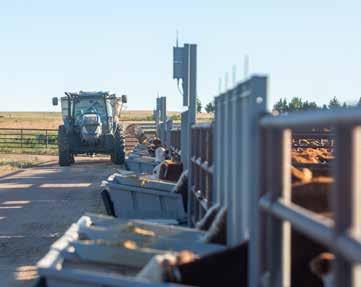


PRSRT STANDARD U.S. POSTAGE PAID Jefferson City, MO 65101 Permit #303 Winter 2023 | Volume 6, Issue 2
Continued on page 4
Published by Farmers & Ranchers Livestock, Salina, Kansas
BALANCE THE SCALES

Big cows come with big feed bills.
That’s why smart genetic selection pays off in the cow herd. Simmental-influenced cows are an average 74 lb. lighter at maturity than Angus-sired counterparts, according to a recent U.S. Meat Animal Research Center study.a,d


While Simmental is sized for more efficient gains, 20-year genetic trend lines also show the breed offers reliable calving ease, early growth and cow longevity. That’s a balanced herd built for profit.

406-587-4531 • simmental.org STAND STRONG SIMMENTAL aUSMARC, Zimmerman, M., et al., “Breed and heterotic effects for mature weight in beef cattle,” J. of Anim. Sci., Vol. 99, 2021. bAdjusted for sire sampling, Angus was the heaviest at maturity among the 16 breeds evaluated. Solutions are deviations from Angus. YW EPDs were extracted from genetic evaluations conducted in 2019. cEstimate of MWT differences at 6 years of age. dThe study considered 108,857 weight records from 5,156 crossbred cows sired by 787 bulls.
Angus Charolais Hereford Simmental 0 -20 lb. -39 lb. -74 lb. BREED EFFECTS FOR COW MATURE WEIGHT (MWT)abc
By Deb Norton
I like dogs. My very first dog was given to me on my first birthday. For decades now, I’ve owned a dog, or two. Over the years, it seems easier to connect with people that also like dogs. A red flashing warning light goes off if I meet someone who doesn’t like dogs. Driving down the road, seeing dogs hanging out the window, ears blowing in the wind, I automatically think those are happy dogs and the owner must be a good person.
Honest self-analysis, thankfully, brings me to the reality that my emotional attachment has no basis in fact. In reality, my assumption, based on emotion and obvious bias, may be factually erroneous. The owner allowing their dogs to hang out of the window may not be a good person at all. Social media hasn’t helped. We subscribe to pages and follow those that support our beliefs and emotions and ‘like’ and follow subjects, all too often, with little basis in reality.
Our personal opinions and beliefs often get in the way of those pesky facts. It is every professional marketer’s responsibility to embrace and practice objectivity. Data points must be based on… well, real data. Conclusions must be drawn from a factual foundation. It is impossible to develop a long-term strategic marketing plan without facts and a willingness to avoid personal bias.
The beef industry, from gate to plate, is one of the most complex of any supply-demand industry. It’s a cyclical industry that historically tends
From the Editor
to move over a 10-to-12-year cycle. A stakeholder’s position in a specific sector, over time, likely will not always be profitable. A factual analysis of the historical data proves this to be true.
Leading livestock marketing specialist at Oklahoma State University, Dr. Derrell Peel, reported in September 2021, “Cycles have been a feature of the cattle industry regardless of whether the industry is trending larger or smaller. Cattle inventories trended higher from 28.6 million head in 1867 to 132.0 million head in 1975, an increase of 361% over 108 years. Cattle inventories have trended generally lower since 1975. The 2021 inventory of 93.6 million head is down 29.1% from the peak in 1975 but is 226.8% higher than the 1867 level. Cattle cycles reflect a variety of drivers that affect the cow-calf sector, the primary supply source for the industry. Most important among these drivers are changes in calf prices that determine cow-calf sector revenues, but input price changes that likewise impact returns can also drive cattle cycles. Periodic droughts can provoke or prolong cyclical liquidation and have multi-year impacts on cattle industry trajectory. Cattle cycles continue to be a regular feature of the industry for several reasons. It takes rather exaggerated price signals to encourage the cow-calf sector to change course and the lengthy biology of cattle production makes changing course a slow process.”
U.S. Meat Export Federation recently released their export summary documenting the fact beef exports topped $10 billion for only the second time in history. The statistical comparisons over the past couple of years are both exciting and cautionary. The USMEF also reports that, from January through October 2022, exports added $460 PER HEAD to every head of fed cattle slaughtered, up 17% in value.
It is anecdotal and based on my personal experience, that a visit to Sam’s Club or Costco on any given Saturday, is a microcosm of our society (i.e.: consumers). Both big box stores have large, full, meat cases of fresh, high-quality beef. Just a few weeks before Christmas, a quick search on the Costco website lists whole, Choice prime rib at $21.43/lb. Sam’s Club lists Prime ribeye steaks at $19.98/lb. and Prime tenderloin filets for $24.98/lb. For comparison, the most expensive poultry item in the Sam’s Club fresh meat section are chicken tenderloins selling for $4.98/lb.
CattleFax recently reported all fresh retail beef price is positioned to set an average all-time record of $7.25/lb., despite inflationary pressure on consumers. CF goes on to report, “The dollars spent on beef at the retail level is a gauge of the value available to the cattle industry as a whole. Furthermore, evaluating price relationships between segments provides insight on leverage or the ability of each segment to capture a portion of this value.” This information is based
Apex Cattle
Hunt
J&N
Jamison Herefords 23 Feb. 24
Don
KSU
Laflin Angus

Loving Farms 30 March 4
Mushrush Ranches 31 March 17
Nichols Farms 14 Jan. 28
Post Rock Cattle 25 Feb. 25
Schiefelbein Farms 11 Feb. 18
F&R Livestock Resource page 3
Sale Date Produced by www.CogentIdeasInc.com Livestock Resource F&R Volume 6, Issue 2 Winter 2023 Published quarterly by Farmers & Ranchers Livestock, Salina, Kansas 1500 W. Old Hwy 40 Salina, Kansas 67401 (785) 825-0211 • (785) 826-1590 (fax) FandRLive.com find us on Facebook Facebook.com/FarmersAndRanchersLivestock
Designer: Daric
Dixie
Sara
Sales
Subscriber Questions: To be added or removed from our mailing list, contact Julie
Julie@
or
F&R Livestock Resource is published quarterly with mail dates of January 15, March 1, August 15 and October 1 by Farmers & Ranchers Livestock, Salina, Kansas. Continued
page 31
in F&R Advertisers / Page /
Owner: Farmers & Ranchers Livestock, Mike Samples, Salina, Kansas (785) 826-7884 Editor: Deb Norton, Deb@CogentIdeasInc.com Production Coordinator: Julie Tucker Graphic
Wells Editorial Assistants:
Russell, Dave Cumpton Contributing Editors: Wes Ishmael, Paige Nelson,
Gugelmeyer Contributing Artist: Ted Foulkes
Jay Carlson Carlson Media Group, LLC (913) 967-9085
Tucker,
CogentIdeasInc.com
(785) 408-1214.
on
Farmers & Ranchers Upcoming Sales and Events Cow Sales (Tuesdays, 11:00 AM) Feb. 21, Mar 21, April 18, May 2 Weaned/Vaccinated Sales (Tuesday, 11:00 AM) Feb. 7 Hog Sales 2nd & 4th Monday Each Month Spring Spectacular Catalog Horse Sale May 20 Don Johnson Angus Bull Sale March 6 New Frontier Bucking Bull Sale March 25 (tentative) For advertising information, contact: Jay Carlson | Carlson Media Group (913) 967-9085 • Jay@CarlsonMediaGroup.com Don’t miss our next issue Spring 2023.
I Like Dogs
19
Mill Brae
22
Jan. 30 Bar S Ranch 20 March 11 Barrett Cattle &
Ranch
March 24 BJ Angus Genetics 18 March 9 Cow Camp 7 Feb. 3 44 Farms 15 Feb. 25
Gold Bullion 20 March 5
Green Garden Angus 24 April 3
Limousin 16 Jan. 31
Ranch, LLC 17 Feb. 11
Johnson Angus 16 March 6
Legacy Sale 22 March 3
29 March 4
Farmers & Ranchers Livestock Commission Co., Inc. Salina, Kansas • (785) 825-0211
Seedstock Plus 27 Feb. 25; March 4, 11, 25
1976, compared to around 685 lb. per head last year (see Fig. 2).
Statistics like that are important when calculating how many pounds of beef are produced per live animal and putting that against greenhouse gas (GHG) emissions of the U.S. beef system per head. That math leads to what’s commonly called “emissions intensity,” (GHG per pound of beef), a figure that has been trending down, or improving, over time.
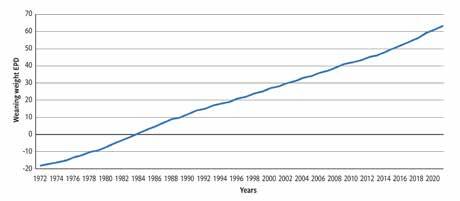
John Crowley, consulting geneticist with AbacusBio, says cattle have been getting better, and that improves GHG emissions intensity, most notably enteric methane, which is the second-most important on the list behind carbon dioxide.
“Improving profitability and improving emissions intensity, which would be the amount of greenhouse gas per kilo of carcass produced, they’re very well-correlated. Probably just by improving profitability through genetics at the moment, we’re doing a good job on greenhouse gases,” he notes.
In the Angus world, feed intake came online as a measurable trait in late 2014, allowing breeders to make selection decisions that include that performance measure.
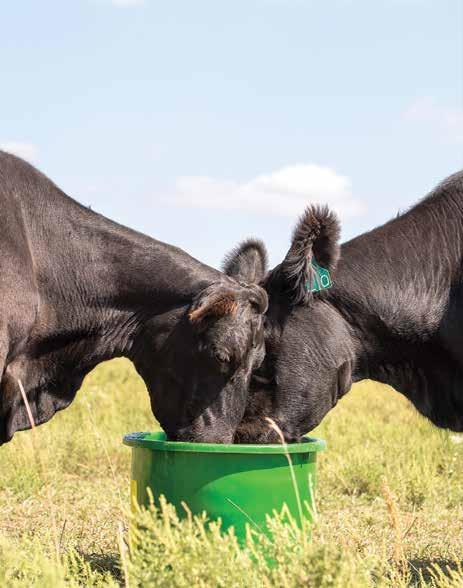
“We continue to push that efficiency envelope and being able to create animals that can do more with less,” Retallick-Riley says.
Compared to other countries, the U.S. beef industry is already in a strong position.
“The U.S. makes roughly 4 to 5 billion pounds more beef per year than Brazil, but we have a cattle herd size that is less than half what Brazil’s is,” says Sara Place, animal scientist with AgNext at Colorado State University. “There’s just more maintenance requirement, more enteric methane, more manure, more feed requirements to produce the same amount of human nutrition out of their cattle herd because of that.”
The Tradeoffs
If it were as easy as producing more beef from each animal on feed,






cattlemen could rest easy knowing the formula for that improvement already exists. However, there are often tradeoffs, and the whole picture is more complex, Crowley says.
“If we’re challenged with reducing gross emissions, then those productivity traits will probably take a bit of a hammering, and we’ll have to reduce productivity,” he says. “If gross greenhouse gas reduction is the end goal, what’ll come into focus is your cost-saving traits, and saving cost is going to replace any revenue that’s lost by increased productivity.”
It will be trading maximums for optimums, he suggests.
What does that mean in practice?
“We’ve selected animals from a feedlot standpoint that are going to gain more and that are larger at the end of their life to produce more beef per animal,” Place says. “Of course, the consequence of that is the cows have also gotten bigger.”
When considering the inputs those bigger, more productive cows require against the emissions equation, the beef industry hasn’t made the same progress.
“I think we have a lot of opportunity to really think about that in new ways to decrease those maintenance costs, energy costs, but then also the greenhouse gas emission associated with that maintenance of the total herd per unit of beef we’re producing from that herd,” Place says.
The trick is finding the balance and knowing there will be differences in what’s best in each region and even operation to operation, she explains.
Today’s Tools Work
There are things cattlemen can do now.
“Use more of the tools that have been around for quite a long time,” Place advises. “If we can get more folks actually using those tools and actually putting the selection pressure on the cow herd for things we already know will work, improving the overall efficiency of the herd … I think that’s a neat opportunity for us to select for low-methane-emitting animals.”
Thinking more whole life cycle, the
page 4 Winter 2023 Continued from page 1
products are formulated to match the diverse nutritional requirements of a cow herd and available forage resources. Highly digestible distillers grains are used in high fat, 30% protein, all natural, free choice tubs, cubes and pellets in a nutritional combination designed for optimal performance. 50 lb. Bags and 2,000 lb. Totes Cubes & Pellets PERFECT PASTURE PERFORMANCE n Self limiting n 30% protein, all natural n Highly digestible distillers grains n High fat Tubs KE Feeds • (620) 727-5197 1630 Avenue Q • Lyons, KS 67554 Sales@KEFeeds.com KEFeeds.com
KattleEnergy
Weaning Weight Trend Lines, American Angus Association
Source: American Angus Association 2022
Who needs an IGR when you have BRUTE® Pour-On for Cattle?
Depend on BRUTE® for economical, long-lasting control of biting and sucking lice.
Some pour-on insecticides for cattle depend on insect growth regulators (IGRs) to obtain acceptable lice control. But with the long-lasting killing power of BRUTE® Pour-on for Cattle, there’s no need for an IGR.


Just one application of rain-resistant BRUTE® controls biting and sucking lice for up to eight full weeks. Since lice have a life cycle of just 22 days, that’s long enough to control existing adults as well as emerging nymphs.
What’s more, BRUTE® is labeled for use on lactating and non-lactating beef and dairy cattle, with no pre-slaughter withdrawal requirements or milk withholding restrictions.
To learn how BRUTE® can give you all the lice control you’ll ever need for just 48 cents a head, see your livestock products supplier or visit www.y-tex.com today.
Y-TEX® and BRUTE® are registered trademarks of Y-TEX Corporation. © 2022 Y-TEX Corporation.
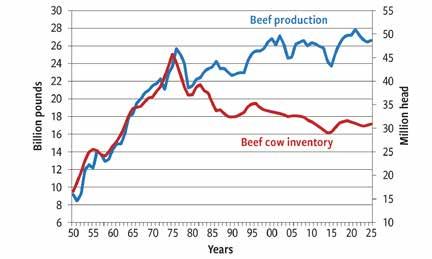

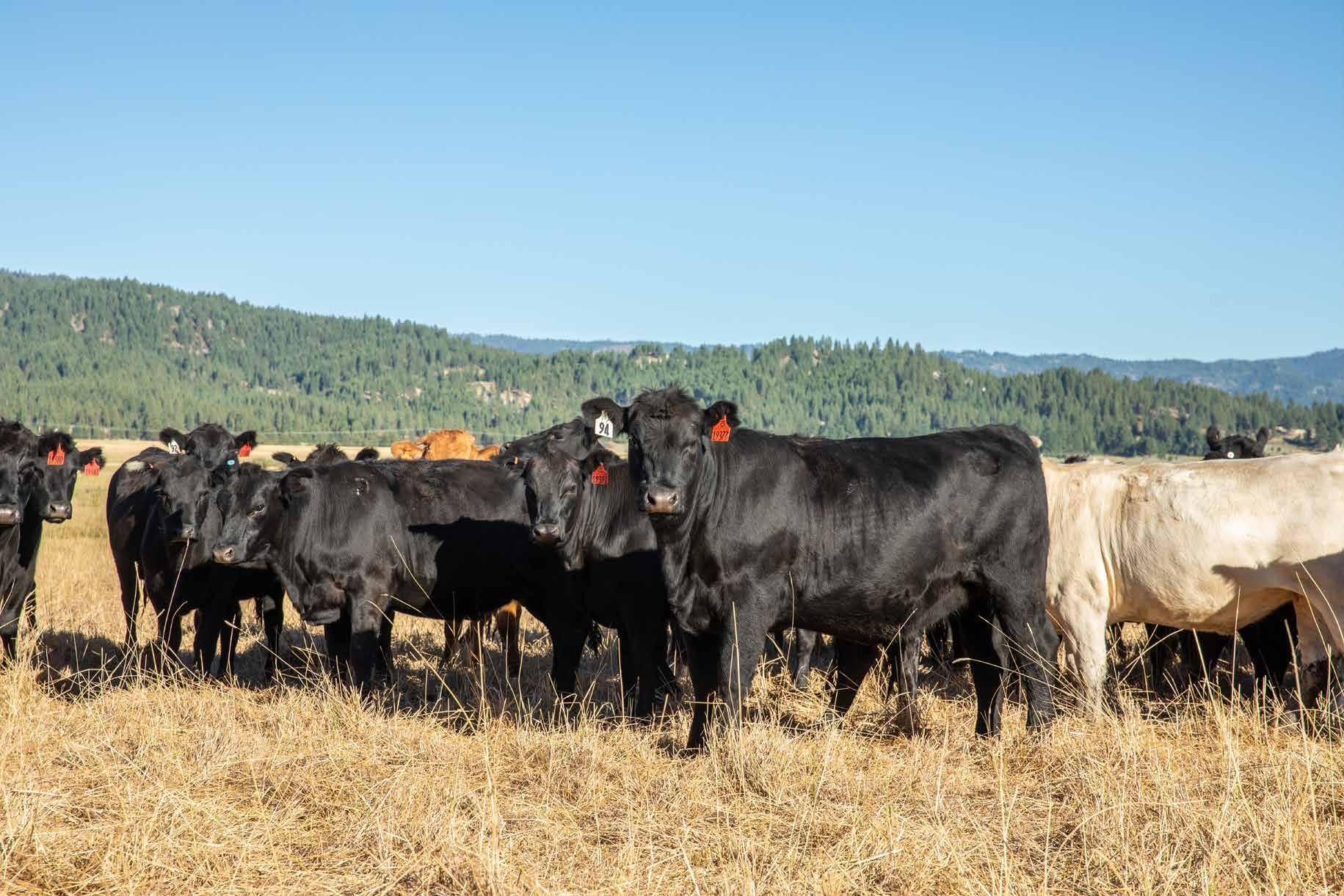
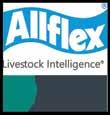
page 6 Winter 2023
Beef Cow Inventory vs. Production Source: USDA, CattleFax Projection 2022 800.989.8247 | www.allflexusa.com
U.S.






































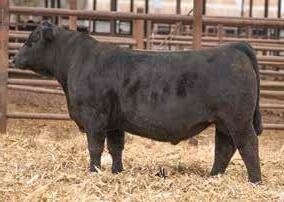





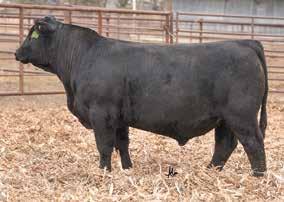



















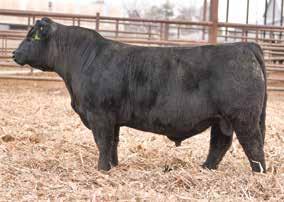


Cow Camp Ranch Five Generations of raising seedstock and feeding cattle. Timele Cow Camp Ranch SPRING BULL SALE 1:00 PM CT February32023 185 Age Advantaged Simmental and SimAngus™ Bulls Sell Entire o ering of 2022 Spring Born Heifers including daughters of 3 featured Cow Camp Donors Also selling 2 Elite Fall Bred Heifer Donor Prospects Marty Ropp 406-581-7835 Corey Wilkins 256-590-2487 Jared Murnin 406-321-1542 www.alliedgeneticresources.com COW CAMP RANCH LOST SPRINGS, KS bullsale@cowcampbeef.com www.CowCampBeef.com Kent Brunner 785-466-6475 Mark Brunner 785-258-0173 Nolan Brunner 785-466-1129 Tracy Brunner/Feed Yard 785-965-2228 The Cow Campadvantage • 57 years raising registered stock • Largest selection of age advantaged SimAngus™ bulls in the United States • Leader in the business for carcass data collection • Customer buyback program and custom feeding options at Cow Camp feedlot • All bulls sell with genomic enhanced EPDs and RightChoice scores Lost Springs, KS ASA 4028639 || Homo Black, Homo Polled TEHAMA PATRIARCH F028 x CCR COWBOY CUT 5048Z CE BW WW YW MILK STAY DOC CW MARB REA API TI 14.8 -1.8 79.3 124.2 26.3 17.4 14.0 38.4 0.51 0.72 153.4 87.3 CCR 8636 PATRIARCH 3355J ASA 4028670 || Homo Black, Homo Polled LBRS GENESIS G69 x CCR CATALYST 7035W CE BW WW YW MILK STAY DOC CW MARB REA API TI 14.3 -0.8 85.9 128.2 28.7 20.8 9.6 49.1 0.97 0.68 184.6 101.5 CCR GENESIS 4142J ASA 4028702 || Homo Black, Homo Polled CCR POUNDER 2045F x JC MR NATIONAL 610Y CE BW WW YW MILK STAY DOC CW MARB REA API TI 13.7 0.7 88.1 142.6 27.4 21.4 19.1 48.0 0.71 0.51 170.9 94.8 CCR POUNDER 4503J ASA 4028738 || Homo Black, Homo Polled TEHAMA PATRIARCH F028 x CCR COWBOY CUT 5048Z CE BW WW YW MILK STAY DOC CW MARB REA API TI 15.0 -1.2 87.4 141.1 23.6 15.9 13.3 64.0 0.84 0.84 172.0 99.9 CCR BEDROCK 5171J ASA 4028971 || Homo Black, Homo Polled HOOK`S GALILEO 210G x CCR COWBOY CUT 5048Z CE BW WW YW MILK STAY DOC CW MARB REA API TI 17.8 -2.0 84.4 131.0 30.8 20.5 18.7 33.0 1.00 0.59 192.9 103.8 CCR MS 4085 GALILEO 1297J ASA 4029010 || Homo Black, Homo Polled EGL FIRESTEEL 103F x BALDRIDGE COMMAND C036 CE BW WW YW MILK STAY DOC CW MARB REA API TI 12.7 1.1 96.3 155.7 27.6 16.0 8.6 53.4 0.90 0.91 172.6 104.6 CCR FIRESTEEL 8081J
The Yardstick
“The biggest challenge right now is to be able to set our goal posts,” Retallick-Riley says.
Before there’s a genetic index for sustainability or another tool, there needs to be a consensus on what traits contribute and a standard on how to address those.
“You can’t manage what you don’t measure, and you definitely can’t manage what you can’t measure when you don’t know what to measure,” she says.
Then the challenge is collecting phenotypes on hard-to-get traits, such as methane emissions. Researchers have collected limited data in respiration chambers, but new technologies could allow for easier capture in the future. The Angus Foundation recently funded Kansas State University research using GreenFeed systems to spot-sample multiple respiration patterns throughout the day and understand more.
“If we can work with the research community and look for correlated traits that can capture this in the commercial beef industry, that’s how we’re going to have to drive this forward,” Retallick-Riley says.
Actual methane measurements on a smaller population could help identify those correlations to create a tool, similar to the way feed intake is measured on a smaller number of animals and applied to the larger herd.
“Genomics allow us to tie those animals back to the reference data,” she says.
Crowley says it’s important to get it right in this discovery and research
phase. For all the animal science community across the globe has learned, there are still many unknowns.
“You have to have due diligence around whether you’re selecting for the right things. You don’t want to select for a reduced energy demand and it have a negative consequence,” he explains.
If you can make good progress with the right tools, you can also magnify
mistakes with the wrong ones, Crowley says.
There are advancements in the management space — from feed additives to improvements in crop production — but he is encouraged by the lasting effect genetics could have.

“When it comes to sustainability, genetics as a solution is going to be cumulative and permanent,” he says. “It’s a good cost-effective way to mitigate greenhouse gas emissions. With any trait, you have a genetic component and a management component. The genetics piece works quite well, because it locks in gain over a long period of time. It changes the population’s genetics to have a more sustainable herd.”
It seems “bred-in continuous improvement” could become the popular phrase of the next decade.
Editor’s note: John Crowley covered “Fitting Environmental Impacts Into Economic Selection Indexes” at the 2022 Beef Improvement Federation meetings in June. Sara Place presented “Beef Sustainability: Opportunities for Genetic Improvement” as part of the National Beef Cattle Evaluation Consortium’s 2021 Brown Bagger Series.
This article originally ran in the December 2022 Angus Journal. Reprinted with permission.

page 8 Winter 2023 Farmers & Ranchers Livestock Comm. Co., Inc. Salina, Kansas For More Information, Contact: Farmers & Ranchers • 785-825-0211 | 785-826-1590 (fax) | www.fandrlive.com Mike Samples, Manager • 785-826-7884 | Kyle Elwood • 785-493-2901 Spring Spectacular Catalog Horse Sale May 20, 2023 • 10 AM Ranch Horse Competition • Friday, May 19 (Catalog Horses Only) Roping & Performance Preview • Friday, 1 PM • Saturday 7:30 AM Selling 300 Horses Only! 7% Commission $20 Pass Out Fee • $30 Substitution Fee 72-Hour Soundness Guarantee Catalog closes March 1 or first 300 horses! Kansas’ Connection for Ranch & Rope Horses
to
tolerance
heat or altitude, which is both a welfare benefit and improves reproduction and efficiency.
Docility EPD Trendline, American Angus Association
Source: American Angus Association 2022
Salina, Kansas
Fall Classic Catalog Horse Sale
Lot Consignor Name Assoc $ Notes 99 Hughes, Jacob Silk Jet 19
AQHA $15,000 19 brown mare granddaughter of Sunfrost Riata Buckle Eligible 44 Flinn, Marlene Flinns Poco Razz AQHA $12,500 11 bay gelding by a son of Jimmer Playboy; ranch horse 11 David, Stephanie Bet Hesa Goldseeker AQHA $10,200 17 sorrel gelding grandson of Frenchmans Guy; Ranch, Barrels 66 Watson, Regan Command Count AQHA $9,000 08 brown gelding by Grandson Gay Barking; Team Rope 80 Penner, Cody KC Shes A Tidy Cat AQHA $9,000 19 sorrel mare granddaughter of High Brow Cat; Ranch 50-2 Harris, Chad GM Lynx AQHA $9,000 19 sorrel gelding 3rd place futurity $4,350 10 Rossel, Dick HR Seventh Gun AQHA $8,750 19 gray gelding by Played; futurity placed 7th $1000 48 Hudson, Tony GM Poco Gold AQHA $8,700 16 palomino gelding by Grandson Jackie Bee; ranch, trail 101 Hughes, Gary Jessies Smooth Cat AQHA $8,700 17 sorrel gelding by Jessies Velvet Sug; heel horse 41 Higgs, Franklin Cholla Rondo AQHA $8,500 19 sorrel gelding double bred Moleo Rondo 8 Brown, Cindy My Pal Jac AQHA $8,250 12 palomino gelding grandson Mr Holly Jac; ranch/team rope 42 Bixenman, Bailey Chex Bee Rocking AQHA $8,000 15 sorrel gelding by Grandson Dual Rey; ranch, versatility 89 Hudson, Tony Blue Moon Romp AQHA $8,000 18 blue roan gelding by El Cutie; ranch 27 Beverlin, Casey&Jamie Leo Lena Lariat AQHA $7,900 19 palomino gelding by Taco Tuck Leo; futurity 4th place $2,800 50 Mccartney, Lewis Poco Bay Visitante AQHA $7,500 17 bay gelding by Poco Bueno Ojos; family horse 76 Setting Sun Ranch Little Meradas Dust AQHA $7,500 12 dun mare by Grandson Dual Rey; ranch 97 Hall, Trevor Krogs Boon AQHA $7,500 19 sorrel gelding by Can’t Kick This Cat 111 Penner, Cody Buck Duece King AQHA $7,200 10 buckskin gelding by Burtons King; ranch

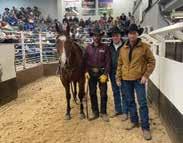

25th Annual Colt & Yearling Sale
Shynas Star $10,200 21 sorrel stallion 375 Beery, Neal
It To Ya Twaynas Starlight Dr $7,000 21 sorrel filly 398 Bashor, Dave
Pending Dualin Six Shooters Paleliz $7,000 22 dun stallion 374 Joe Bevington
San Badger AQHA Peppys Gold Colonel Miss Callies Girl $6,700 21 palomino gelding 382 Barner, Dan CS Metallic Fire AQHA Smart Red Socks Pg Little Fire $5,500 21 gray filly 422 Beery, Neal Nap Time AQHA JM On Time Little Cat Nap $5,500 21 red roan filly 425 Ohlde, Trudy Docs Liberty Light AQHA Renos Black Lite Docs Sandy May $5,200 21 gray filly 418 Davis, Presley HX You Watching Me AQHA SDCC Cinco De Mayo Meradas Little Cat $5,100 21 sorrel stallion 236 Delaney, Sierra Two Eyed Champ AQHA GQ Champ Parr Bar Two Eyed Fancy Breez $5,000 21 buckskin gelding 253 Vinton Quarter Horses JV Gallo San Frost AQHA Pending Gallo Vaquero JR Driftwood Jaze $5,000 22 bay stallion 290 Vinton Quarter Horses DMV Shabbywood Bars AQHA JR Driftwood Bars Brat Shabby $5,000 22 blue roan stallion 300 Doty, Jim & Shelby Favorable Metallic AQHA Cowed Up Duches Te Two $5,000 22 dun stallion 426 Barner, Dan AQHA Pending One Time Royalty Fancy Merada Wood $5,000 22 bay filly 437 Bashor, Dave Dual Miller AQHA Pending Dualin Six Shooters Missdmill $5,000 22 bay stallion 278 Vinton Quarter Horses JV King Sammy AQHA Pending King Bars Blanton JV Blue Sammy $4,800 22 bay stallion 289 Crowther, Jimmy Jaycee Boon
Krogs Little Cat Tangs Boonlight $4,800 22 red roan stallion




Farmers & Ranchers Livestock Comm. Co., Inc.
HX Made To Order
77 Beverlin, Casey&Jamie
AQHA $7,000 19 black mare granddaughter Paddys Irish Whiskey; futurity 119 Vanover, Kegan Wilson Grade $6,500 09 sorrel gelding grade; head horse
Lot Consignor Name Assoc Sire Dam $ Notes 350-1
Wright Round AQHA High Brow Cat Sliden Wright By
21
filly 217
Smooth Asa Shiner AQHA Smooth As A Cat Playin
Fortune
22
Buck Metallic
MP
Gold
Kuntz, Dusty Hotroddin CD AQHA My Lifes Delight Bar Cross Hot Jackie $4,400 21 sorrel stallion 2022 Futurity Results Reining Horse’s Name Owner Rider Nominator Stallion Score $ Won 1st CS Bet Hes Royal Dan Barner Alesa Barner Dan Barner Hesa Mecom Cat 50 600 2nd Crowning At The Moon Dan Barner Dan Barner Travis Hodson Moonstruck Pepto 38.5 400 Cow 1st CS Bet Hes Royal Dan Barner Alesa Barner Dan Barner Hesa Mecom Cat 40.5 600 2nd Bar Time Brandee NB Neal Beery Sam Gallaher Neal Beery JM On Time 34 400 Trail 1st GM Lynx Chad Harris Chad Harris Gary Miller Colonel Cowhores 2.37 600 2nd CS Bet Hes Royal Dan Barner Alesa Barner Dan Barner Hesa Mecom Cat 2.43 $400 Total 1st CS Bet Hes Royal Dan Barner Alesa Barner Dan Barner Hesa Mecom Cat 58 $5,619 2nd Crowning At The Moon Dan Barner Dan Barner Travis Hodson Moonstruck Pepto 48 $4,682.50 3rd GM Lynx Chad Harris Chad Harris Gary Miller Colonel Cowhorse 45 $3,746 4th Leo Lena Lariat Casey Beverlin Casey Beverlin Cindy Moore Taco Tuck Leo 30 $2,809.5 5th Jaycee Rosa Matt Moore Matt Mooore Jimmy Crowther Shooter Cat 27 $1,873 6th Bar Time Brandee NB Neal Beery Sam Gallaher Neal Beery JM On Time 22 $1,000 7th HR Whiskey Shotgun Dick Rossell Travis Merritts Rozin & Emmylu Hill Played 19 $1,000 8th Jaycee Lil Hideaway Josh Lilley Josh Lilley Jimmy Crowther Krogs Little Cat 18 $1,000 Nominator: Dan Barner, 500 For More Information, Contact: Farmers & Ranchers • 785-825-0211 | 785-826-1590 (fax) | www.fandrlive.com Mike Samples, Manager • 785-826-7884 | Kyle Elwood • 785-493-2901 Top 5 Avg.: $14,440 Top 10 Avg.: $10,210 Top 15 Avg.: $8,480 Top 20 Avg.: $7,560 Futurity Winner Top Selling 2nd High Selling Top 5 Avg.: $11,140 Top 10 Avg.; $9.935 Top 15 Avg.: $9,267 Top 20 Avg.: $8,735 Top Selling 2nd High Selling 4th High Selling 3rd High SellingSelling
Shelley, Cody
$33,500
sorrel
Barner, Dan
With
$11,000
chestnut filly 325 Haythorn Land & Cattle
AQHA Four Metallic Buck Snickle Fritz $10,500 21 palomino stallion 400-1 Shelley, Cody
Blantons
AQHA MP Roc Kat Barons
Metallic Midnight AQHA Whats
Velvetshooter AQHA
Goldboy
Cat AQHA
298
Sustainability Snapshot, Part 1
Facts to share.
By Wes Ishmael
Discussions about greenhouse gas emissions’ (GHG) role and cattle’s contribution to global warming can get deep and confusing in a hurry. With everything from the science and interpretations of the science to misinformation to raw emotions muddying the conversation, here are some key points and facts to keep in mind when such discussions occur.
Rather than being a culprit, beef cattle in the United States have the potential to contribute to reducing greenhouse gas (GHG) emissions
that contribute to global warming.
As a ruminant animal, beef cattle convert forages inedible by humans into nutrient-dense beef that is edible by humans—upcycling.

“Approximately 29% of the land in the United States is too wet, rocky, steep or arid to support cultivated agriculture.1 However, cattle graze on plants native to their surroundings that humans can’t eat,” according to Cattle: The Ultimate Upcyclers. “Their unique, four-compartment stomach and digestive system is home to trillions of microbes. These microbes allow cattle to benefit and gain nutritional value from these sources that other animals can’t digest.”
Urgent Global Needs
“We know cattle are natural upcyclers. We also know how much more efficient U.S. beef production has become over time in terms of producing more beef with fewer cows on less land. The American cattle producer is the most efficient in the world,” says Jack Ward, executive vice president of the American Hereford Association (AHA). “But we also know the global population is expected to grow by almost 2 billion by 2050. So, how do we become more efficient and how do we, from a genetic standpoint, affect overall sustainability?”
The International Database (IDB) estimated the world population at 7.9 billion in 2022, 8.5 billion in 2030 and 9.7 billion in 2050. IDB estimates for the U.S. population are 337.3 million in 2022, 355.1 million in 2030 and 388.9 million in 2050.
The Food and Agricultural Organization (FAO) of the United Nations estimated 720 to 811 million people faced hunger in 2020.2 FAO estimated that 22% (149.2 million) children under 5 years of age were affected by stunting, 6.7% (45.4 million) were suffering from wasting and 5.7% (38.9 million) were overweight.
In 2021, USDA’s Economic Research Service (ERS) estimated 10.2% (13.5 million households) in the United States were food insecure.3 “Food-insecure households had difficulty at some time during the year providing enough food for all their members because of a lack of resources,” according to the ERS report.

At the same time, the global average surface temperature continues to increase.
According to the 2021 Annual Climate Report from the National Oceanic and Atmospheric Administration (NOAA), the combined land and ocean temperature has increased at an average rate of 0.08 degrees Celsius per decade since 1880. The average rate of increase since 1981 has been more than twice that
page 10 Winter 2023
These unites at Olsen Ranches, Harrisburg, Neb., collect individual methane emissions for the collaborative research project between the AHA and Colorado State University.





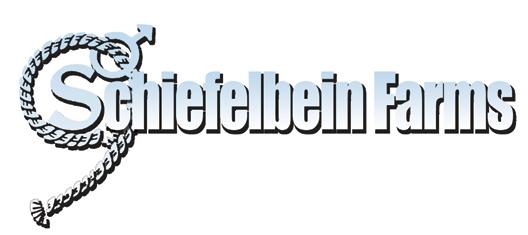




Find Your Bull Here! ✦ Saturday, Feb. 18, 2023 Friday, February 17, 2023 12 noon Viewing of Sale Cattle 2 till 5 pm Tour of the Farm 4 till 6 pm Social Hour (Free Drinks & Appetizers) 5 pm Celebrating the Life of Big Frank 6 pm Free Prime Rib Dinner with all the fixings Plan to join us for these events: (NOTE: All events will take place at the sale facility) Saturday, February 18, 2023 9:00 am Viewing of Sale Cattle 10:30 am Free Beef Lunch 11:00 am 2023 Sale Begins www.schiefelbeinfarms.com Sale to be broadcast live! Contact us today! Visitors always welcome. 34897 717th Ave., Kimball, MN 55353 320/266-8487 (Dan) • 320/224-5830 (Tim) • 303/324-5149 (Don) info@schiefelbeinfarms.com • www.schiefelbeinfarms.com • Free Delivery • Sight Unseen Guarantee • DNA Tested through Schiefelbein Untouchable Let us help you top the market! 32nd Annual Bull & Female Sale Don’t Miss One of the Nation’s Largest Angus Sale! Find us on Facebook Featuring large groups of the breed’s leading sires: plus many, many more. Showman Untouchable Growth Fund Wall Street DB Iconic Poss Rawhide GAR Home Town Connealy Big Valley Connealy Emerald Linz Exemplify LD Capitalist VAR Fire Power Sitz Resilient Sitz Stellar Ellingson Three Rivers Baldridge Alternative Schiefelbein Spotlight Schiefelbein Skol Schiefelbein Endgame Schiefelbein Attractive Schiefelbein Revolver 400 Bulls Sell... Sat., February 18, 2023 • 11 a.m. at the farm near Kimball, MN Registered Angus Bred Heifers Sell! Plus His first sons sell! CED BW WW MK YW SC DOC $M $C 13 -0.9 91 34 168 0.68 22 65 280 Powerful Cattle with Unmatched Looks
rate at 0.18 degrees Celsius.
The United Nations’ Paris Agreement on Climate Change—the United States is a member—seeks to limit global warming to well below 2 degrees Celsius and preferably to 1.5 degrees, compared to pre-industrial levels. Depending on the literature reviewed, scientists and policymakers say global temperatures beyond 2 degrees (Celsius) warmer than pre-industrial temperatures pose significant risk to the earth’s population.
Reducing GHG is a key strategy to achieve the temperature goal. Carbon dioxide, methane and nitrous oxide receive the primary reduction focus.
Cattle and GHG
“Greenhouse gases associated with the beef industry include carbon diox-
ide, methane, and nitrous oxide. However, there’s a clear difference between biogenic carbon (ruminant digestion), and carbon from fossil fuels,” according to Beef’s Role in Greenhouse
WHOA.
Gas Emissions. “While the biogenic carbon cycle happens on a short time scale, the cycle of carbon from fossil fuels takes 1,000 or more years. This is because carbon from burning fossil
fuels comes from deep geological reserves (e.g. deep soils) that take thousands of years to be redeposited after being released. Therefore, while biogenic carbon has a short-lived impact on our climate, carbon from fossil fuels has a longstanding, and much more significant impact on the environment.”4
Beef cattle produce approximately 2% of U.S. GHG emissions, according to the U.S. EPA’s GHG emissions inventory.5 Key sources are enteric methane—a byproduct of rumen fermentation—along with methane and nitrous oxide from manure.
In fact, the nation’s brood cow herd produces about 70% of beef cattle’s carbon footprint in the United States.6 Enteric methane emissions from beef cattle represent 1.8% of total U.S. greenhouse gas emissions and approximately 27% of methane emissions in the U.S., according to the EPA.
MORE POUNDS. MORE CALVES. MORE PROFIT.
Herefords are known as the efficiency experts for a reason.
Herefords boost pregnancy rates by 7% and add $30 per head in feedyard profitability in a crossbreeding system. And Hereford genetics bring unrivaled hybrid vigor, longevity and disposition.
Come home to Hereford.
“Between 1961 and 2019, the U.S. beef industry, through continued sustainability efforts and improved resource use, has reduced emissions per pound of beef produced by more than 40% while also producing more than 67% more beef per animal.7,” according to Beef’s Role in Greenhouse Gas Emissions. “Emissions from cattle, including those that come from the feed production, fuel and electricity account for 3.7% of the total greenhouse gas emissions in the U.S.8 Currently, emissions from U.S. beef cattle are less than 0.5% of the world’s greenhouse gas emissions.8,9 Emissions from beef cattle represent 2.2% of total U.S. greenhouse gas emissions.”8
Even so, societal focus is demanding a smaller carbon footprint from the U.S. beef cattle industry. That requires increased production efficiency along with ways to directly reduce GHG emissions.

Genetics serve as an example of the latter.
Ward explains the Hereford breed is the first in the U.S. to tackle understanding genetic opportunities to reduce methane emissions and nitrogen excretion. Previous research indicates genetics play a significant role in both.
Documenting Breed-Specific GHG
The American Hereford Association is conducting collaborative research with Colorado State University’s (CSU) pioneering AgNext program to evaluate the breed’s genetics for methane production and nitrogen excretion.

Hereford.org | 816-842-3757
“Beef industry stakeholders including the National Cattlemen’s Beef Association have committed to improving the environmental impact of U.S. cattle production. This project aims to develop a selection tool for the
page 12 Winter 2023
AHA 7x9 4c-F&R.indd 1 9/15/22 3:11 PM
Olsen Ranches, Harrisburg, Neb., installed GrowSafe systems in 2010, adding individual feed intake phenotypes and feed efficiency data to the AHA National Reference Sire Program.







Acceleration Disciplined breeding, genomic information, accurate selection tools, phenotypic performance and carcass data enable genetic acceleration. GAR Home Free 19862808 Sire: GAR Home Town Dam: GAR Momentum F266 Proven genetics, moderate stature, elite calving ease, marbling and ribeye. Semen: $30 / $40 certificate GAR Dual Force 20218580 Sire: GAR Dual Threat Dam: GAR Early Bird N895 Outcross opportunity on Home Town daughters with unique balance for calving ease, early growth, marbling and muscle. Semen: $30 / $40 certificate GAR Home Team 19862954 Sire: GAR Home Town Dam: GAR Prodigy 1558 Powerful combination of Home Town, Prodigy, Prophet and Sunrise genetics with elite calving ease, growth, marbling and muscle. Semen: $30 / $40 certificate To order semen, contact the AVC semen sales hotline. AshlandVetCenter@gmail.com (888) 250-3707 • AshlandVetCenter.net
Genetic
Our bull buyers are all unique. Their needs are our needs and we understand the best time to buy a bull is different for all. Because of this, we strategically plan to have a great selection of bulls available at private treaty throughout the Spring sale season.
At Nichols Farms, all of our sale bulls are backed by a cowherd with 72 years of selection pressure. We breed for growth, carcass traits, mothering ability, sound feet and good disposition. If a cow does not produce, she goes to town.
We have developed six genetic lines. All different, all with various breeding strengths and reasons to use.
We invite you to come take a look or give us (Dave or Ross) a call to discuss which genetic line works best for you. Should you want to give us a call and take advantage of our “Sight Unseen Purchase Plan,” this comes with our satisfaction guarantee. We offer this with confidence because of the powerful bull lineup we offer throughout the sale offering.

American Hereford Association and the broader cattle industry that helps producers identify genetics that will have reduced greenhouse gas emissions without sacrificing animal productivity,” says Kim Stackhouse-Lawson, PhD, director of AgNext.
By leveraging existing animal performance data and monitoring animal emissions, Stackhouse-Lawson explains the goal is to identify genetic traits that influence environmental emissions from individual animals and then develop selection indices that can be used to select traits associated with lower emission levels, while maintaining, and ideally improving economic returns to producers.
Specifically, AHA-CSU research aims to enhance understanding of the genetic differences in seedstock relative to enteric methane production and nitrogen excretion.
Methane emission, as a genetic trait in cattle, appears to be moderately heritable with genetic correlations (modest to strong) to economically relevant production traits, such as measures of growth, dry matter intake and various estimates of feed efficiency.10
Previous research also suggests genetics play a significant role in nitrogen excretion by cattle.
“As with other moderate to highly heritable traits, genetic improvement
is available, additive and permanent,” Ward says. “That’s a distinct advantage compared to options such as feed additives and feed processing, which must be continually added to the system.”
Ward emphasizes the U.S. beef cattle industry has a long history of demonstrating extraordinary gains in efficiency over time, using genetics, technology and management to produce more beef with fewer cows and less land.

“Increasingly, we also believe this kind of documentation will be useful to those in the supply chain who are required to track Scope 3 emissions,” Ward says. “Overall, we believe this research will help us identify ways to magnify the gains the industry has already achieved.”
Genetics for Efficiency
“Over time, we’ve documented the value of Hereford genetics in commercial cow herds in terms of fertility, longevity, feed efficiency and other traits associated with production efficiency. All of those things, as we understand currently, are going to have a positive effect in terms of sustainability as we move forward in the industry,” Ward says.
The Hereford breed’s inherent genetic advantages for production
Nichols Farms has made a major investment in a C-lock SMART-FEED feed intake system. This Nichols Farms unit will handle about 300 bulls per test cycle. The second cycle is for the Hybrid and Composite bulls. Each cycle gets actual feed intake, live body weights, rate of gain (ADG) and residual rate of gain (FCR). One cost for beef animals is the feed/forages that accounts for 75% of the retail cost of a beef steak. With corn priced at $6.50 bushel and big round bales of fescue and brome hay is fetching $100, the handwriting is on the wall.

page 14 Winter 2023
Bull Barn: (641) 369-2829 • Ross Cell: (641) 745-5241 Dave Cell: (641) 745-5730 Nichols Farms It’s More Than Just a “One Day Private Treaty Bull Sale” Opening Day: Saturday, January 28, 2023 400 Bulls • 6 Genetic Lines Angus • Simmental • South Devon • Nichols Composites Nichols SX1 • DX1 Hybrids Good: $4,000 • Better: $4,500 • Best: $5,000 Bull Sale Catalogs • www.nicholsfarms.biz 2188 Clay Ave, Bridgewater, Iowa 50837

F&R Livestock Resource page 15 A PROGRAM to SADDLE UP WITH We invite you to consider being part of Prime Pursuits, a paradigm-changing program designed to bring together top producers with industry-leading genetics to deliver the best Angus beef to America’s table through a partnership with Walmart. To learn more, visit PrimePursuits.com or contact Warren White at 806.414.5858. SPRING BULL SALE FEBRUARY 25, 2023 . CAMERON, TEXAS FOR MORE INFORMATION, CONTACT ONE OF OUR TEAM MEMBERS: Tracy Woods 405.880.3866 Tyler Gray 208.590.6167 Jarrod Payne 308.870.6348 Jill Ginn 806.570.6185 TO RECEIVE A SALE BOOK, PLEASE CALL 254.697.4401 OR VISIT 44FARMS.COM
efficiency enhance the opportunity for beef cattle to reduce GHG emissions while providing more pounds of beef per cow bred.




Feed efficiency is perhaps the most striking Hereford advantage.
Consider data from the U.S. Meat Animal Research Center documenting that Hereford consumed 1.7 pounds less feed per day when compared to Angus. This advantage equated to 191 pounds less corn per Hereford steer during the feeding period.

For broader perspective, this advantage multiplied by the number of fed cattle marketed as Certified Hereford Beef® in fiscal year 2021 equates to saving 31.6 million pounds of corn— enough corn to feed a 100,000-head feedlot for 19 days. Given that it takes about 54 gallons of water to produce 1

pound of corn, the Hereford advantage in this example saves an estimated 1.7 billion gallons of water.
Increased feed efficiency is also evident in the pasture. Research conducted by Oklahoma State University (OSU) documented that Hereford-sired black baldy females consumed about 2 pounds per day less moderate-quality forage (Oklahoma pasture) compared to straightbred Angus peers. On an annual basis the black baldy cows would be expected to consume about 725 pounds less forage.
“By using the crossbred female and taking advantage of lower feed intake and maintenance requirements of Hereford cattle in our crossbreeding system, we should be able to increase stocking rate or reduce the number of





page 16 Winter 2023 27th Annual Deer Valley Growth Fund CE BW WW YW Milk $W $B $C +9 +1.3 91 169 32 95 161 277 Performance Bull Sale Monday, March 6, 2023 • 6:30PM Farmers & Ranchers, Salina, KS Additional Sires True North, Trailblazer, Governor, Entice, Prime Cut Don Johnson and Linda Egger 6272 E Magnolia Road • Salina, Kansas Don 785-826-5628 • Linda 402-910-3152 tlclivestock@hotmail.com • www.donjohnsonangus.com Call to request a catalog Follow us on for videos & photos NO CREEP All bulls sell with Genomic Enhanced EPD’s All bulls have passed a Complete Breeding Soundness Exam All bulls are born and developed by Don Johnson Family CE BW WW YW Milk $W $B $C +7 +.8 68 122 27 67 167 294 Musgrave 316 Exclusive Sterling Pacific 904 CE BW WW YW Milk $W $B $C +10 +1.6 79 140 19 65 186 320 60 Long-Yearling Bulls 15 Eighteen-Month-Old Bulls Featured Sires Consider the Hunt Advantage • More than 40 years in business • Bulls and females raised under real world conditions • Genetics stressing balanced traits • Bred for docility, growth & calving ease • Calf buy-back program • Guaranteed satisfaction, sight-unseen purchases HUNT LIMOUSIN RANCH Charles & Nancy Hunt Dan, Melinda, Jenna, Adeline & Houston Hunt 10329 Hwy. 136 • Oxford, Nebraska 68967 308/991-3373 (Dan) • 308/920-1120 (Charlie) huntlimo@huntlimousin.com BW 1.1 • WW 72 • YW 106 • MK 22 • DC 13 • MB 0.22 • $MI 62 Limousin & Lim-Flex Bulls for sale at the ranch by private treaty. Hunt Killin Me Smalls 147K 68% • HP/HB • 3/3/22 FILL Danny 211D x HUNT Miss Ace 42F WWW.HUNTLIMOUSIN.COM
for
& Hereford Commercial Herds Private Treaty Sales—75 Bulls January 31 Online Sale—20 Bulls
Bulls
Angus
Cattle grazing at Olsen Ranches, Harrisburg, Neb.




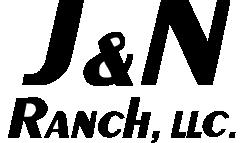

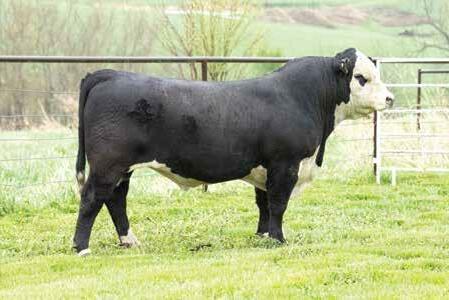



38TH ANNUAL PRODUCTION SALE Birthplace of Black Hereford Cattle SELLING 100 BULLS FREE DELIVERY RECORDED IN VISIT WWW.CATTLETRACS.COM This sale will be broadcast live on the internet. Real time bidding & proxy bidding available. Office (913) 727-6446 • Dirck Hoagland (816) 225-1246 25332 Wolcott Road • Leavenworth, KS 66048 • www.blackhereford.com Watch a video of sale cattle on our website. www.blackhereford.com SATURDAY FEBRUARY 11, 2023 12:30 PM AT THE RANCH JN BALDER 805H JN BALDER D451 JN BALDER F540 JN BALDEE 1540 JN BALDER 805H JN BALDER F637 EFBEEF FOREMOST U208 SCHU-LAR SELECTION 16C SCHU-LAR 913 OF 208 M326 ET JN BALDER F637 HB014414 JN BALDER Z426 ET JN BALDEE 1637 JN BALDER G653 TH 512X145Y KLONDIKE 505B JN BALDER E515 JN BALDEE 1515 JN BALDER G653 HB016179 JN BALDER B448 ET JN BALDEE 1653 JN BALDEE 1138 JN BALDER F674 JN BALDER B844 JN BALDER D036 JN BALDEE 1036 JN BALDER F674 HB014397 JN BALDER A426 ET JN BALDEE 1674 JN BALDEE 519
acres required by about one acre per cow-calf unit,” says Dave Lalman, OSU Extension beef cattle specialist.
However, Hereford genetics also offer advantages in cow fertility and longevity, especially when magnified through heterosis in planned crossbreeding systems.
Previous AHA research documents 7% higher pregnancy rate and more calves weaned per cow exposed, when comparing Hereford-sired black baldy females to straightbred black Angus cows in the same study.

Industry research across decades documents that maternal heterosis yields 38% more cow longevity, 17% more calves produced during the production lifetime and 25% more cumulative weaning weight, among other advantages. Benefits of direct heterosis include almost 2% increased calf survival to weaning and almost 4% more weaning weight.

The bottom line is fewer cows are needed to produce a similar amount of beef, and these cows and their progeny consume less feed to produce a similar amount of beef. This results in a gross reduction of GHG.
If you’re looking for more details about these and other sustainability topics relative to beef cattle, check out the checkoff-funded BeefResearch. org/Programs/Beef-Sustainability and

U.S. Roundtable for Sustainable Beef goals at USRSB.org/Goals.
Reprinted with permission from Hereford World.
Sources
1USDA ERS. 2021. 2012 ERS Major Uses of Land. Found on USDA ERS - Major Land Uses.
2U.N. Food and Agriculture Organization.
FAOSTAT Database – Food and agricultural data. Available at: http://www.fao.org/faostat/ en/#home
3USDA Economic Research Service. Household Food Security in the United States 2021.
4Lynch, et al. 2020. Demonstrating GWP*: a means of reporting warming-equivalent emissions that captures the contrasting impacts of short- and long-lived climate pollutants. Environmental Research Letters 15(4).
5EPA. 2019. Inventory of U. S. Greenhouse Gas Emissions and Sinks: 1990-2017. U. S. Environmental Protection Agency, Washington, D. C.
6Rotz, C. A., B. J. Isenberg, K. R. Stackhouse-Lawson, and E. J. Pollak. 2013. A simulation-based approach for evaluating and comparing the environmental footprints of beef production systems.

7J. Anim. Sci. 91: 5427-5437.


Beef Research. 2021. Quick Stat CalculationsSustainability Research: Statistics on U.S. Improvements in Beef Production and Emission Intensity. (BeefResearch.org/Programs/Beef-Sustainability)
8Beef Research. 2021. Quick Stat CalculationsSustainability Research: Emissions. (BeefResearch. org/Programs/Beef-Sustainability)
9IPCC, 2014: Climate Change 2014: Synthesis Report. Contribution of Working Groups I, II and III to the Fifth Assessment Report of the Intergovernmental Panel on Climate Change [Core Writing Team, R.K. Pachauri and L.A. Meyer (eds.)]. IPCC, Geneva, Switzerland, 151 pp.
10Donoghue et al., 2015; Manzanilla-Pech et al., 2016; Basarb et al., 2013; Herd et al., 2014; Dini et al., 2018
page 18 Winter 2023 21st SPRING PRODUCTION SALE Thursday, March 9, 2023 • 12:30 PM • At the Ranch Manhattan, Kansas After cancelling our 2022 sale due to unforeseen circumstances, we are excited to announce our 21st Spring Production Sale. We hope you will mark your calendar and join us in our Back to Business, 21st Spring Production Sale celebration! This powerful offering features sons and daughters of Home Town, Kansas, Phoenix, Revelation, Ashland, Tahoe and Enhance—all sires that excel for calving ease, growth and carcass value. BJ ANGUS GENETICS John & Bonnie Slocombe 4291 McDowell Creek Road • Manhattan, Kansas (785) 539-4726 • Mobile: (785) 532-9777 • john@bjangus.com www.BJAngus.com Watch the sale and bid live online. SELLING APPROXIMATELY 71 18-Month-Old Bulls 18 14-Month-Old Bulls 5 Bred Donors • 11 Spring Calving Pairs 47 Fall Bred Heifers • 6 Open Heifers 4 Pregnancies • 8 Embryos 25 Bred Commercial Heifers (method genetics tested)
March 9! BJ 4.5x12.875 4c-F&R.indd 1 12/8/22 2:57 PM
90Bulls 75Females
CALL OR CHECK OUR WEBSITE FOR MORE DETAILS www.hydrabeds.com ONLY VARIABLE SPEED WIRELESS CONTROL IN THE BALE BED MARKET PO Box 248 / 902 Hwy 246, Sabetha, KS 66534 800-530-5624 A new day is dawning with our revolutionary new Hydra STX controls ONLY VARIABLE SPEED ELECTRIC CONTROL IN THE BALE BED MARKET
Beef X Dairy: Vision & Reality
The influx of beef-on-dairy crosses offers the industry many benefits and a few challenges.
By Greg Henderson, reprinted with permission, Drovers
Dairymen are rapidly embracing the concept of using beef semen to freshen their cows and the resulting crossbred calves are proving both a valuable opportunity and a challenge for America’s beef industry.
Beef-on-dairy crosses as they are called, deliver on the vision that breed complimentary produces better feedlot performance and improved carcass quality while enhancing industry sustainability initiatives. Such gains are always welcome, but the growth of the beef-on-dairy sector may prove crucial going forward as the beef industry suffers the impact of a second mega-drought over the past decade.
Industry analysts are quick to acknowledge no hard data exists on the number of beef-on-dairy cattle that are part of today’s beef supply, but about three million head, plus or minus.

“I believe the number of beef-ondairy crosses in today’s market exceeds three million head,” says Dale Woerner, animal and food science professor at Texas Tech University. “And the number will continue to grow, especially as the beef cow inventory shrinks.”
Woerner and his colleagues at Texas Tech have collaborated with Cargill over the past three years on the Dairy Beef Accelerator, a program to better understand the opportunities of beefon-dairy. Researchers at Texas Tech have documented several benefits for producers, packers, consumers and the environment. Some highlights:
• Compared to purebred dairy calves, beef-on-dairy calves can provide higher-quality beef products without impacting current milk production efficiencies.

• Beef-on-dairy calves show greater feed efficiency (compared to purebred dairy calves), which lowers the environmental footprint associated with their production.
• Increased feed efficiency significantly reduces greenhouse gas (GHG) emissions.
• The practice benefits meat quality.

Beef-on-dairy delivers increased volumes of higher-grading beef carcasses, providing feedyard operators more access to value-based marketing opportunities as well as pass-back — beef-on-dairy calves are more valuable in the marketplace for dairies than purebred dairy calves.
“The beef and dairy industries have the opportunity to work together to produce even more efficient beef animals,” Woerner said. “Crossbreeding dairy cows to complementary beef sires can advance sustainability by reducing the environmental impact and improving profitability.”
A recent review of beef-on-dairy carcasses and meat characteristics in 2021 found that beef from these
crossbreds compares favorably with traditional beef.
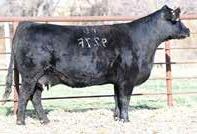





“Dairy-influenced beef has some advantages,” Woerner said. “Primarily tenderness, but also some flavor advantages, too. There’s improved overall palatability or eating qualities in the dairy/beef model over conventional beef.” Woerner said the beef-on-dairy carcasses will produce “more flavor associated with marbling” due to
dairy-type animals typically producing high marbling scores.

While beef-on-dairy programs offer improved utilization of resources for producers and provides carcasses that better fit packer needs, the evolving sector brings some challenges to an industry not quite ready for the influx.
No one understands that better than Ty Lawrence, animal science professor at West Texas A&M, and
F&R Livestock Resource page 19 DAN LEO 308-750-0200 | 1146 7th AVENUE | DANNEBROG, NE 68831 APEXCATTLE.COM AMERICA’S ‘HETEROSIS HEADQUARTERS’ MONDAY - 12:30 PM JANUARY 30, 2023 AT THE RANCH NEAR DANNEBROG, NEB HETEROSIS...DON’T BE IN BUSINESS WITHOUT IT! Nebraska’s Largest Age-Advantaged SimAngus Sale! 100K Genomic Enhanced EPDs and Parentage Verification on Every Lot! ASA #3254156 / PUREBRED HOMOZYGOUS BLACK & POLLED WS PROCLAMATION E202 Featuring the largest assembly of his sons and daughters to ever sell! 90 Powerful Sons and Daughters Featured! CED BW WW YW MCE MILK MWW DOC MARB REA API TI 13.2 0.3 99.9 145.5 9.3 38.7 88.7 18.9 0.55 0.92 166.3 104.3 20% 25% 2% 4% 5% 1% 1% 1% 2% 40% 3% 1% The Breed’s #1 PB Sire! Volume Discounts - Nationwide Delivery Assistance QUALITY + ELITE GENETICS = EXTRA VALUE! EVERY LOT WAS BRED, BORN AND RAISED ON OUR RANCH! 170 PROFIT MAKING BULLS 95 Stout Age-Advantaged and 75 New Generation Yearling Bulls! 90 HIGHLY MATERNAL BRED HEIFERS Featuring the “BEST” in Calving Ease Predictability Sires… TSN Architect J618 by GAR Home Town, -4.1 BW, Top 1% MARB - 174.7 $API & 99.6 $TI JC King of the Road 468H (PB), -3.5 BW, Top 2% BW, MILK, MARB and 176.8 $API 20 HIGHLY PRODUCTIVE YOUNG FALL PAIRS With Proclamation, Eagle and King of the Road calves at side and everyone AI’d back to the great CLRS Homeland 327H sire! APPROVAL x DIVIDEND - Top 5% CE and MARB EPDs! SIMANGUS TM TWO-YEAR OLD BE473J PROCLAMATION x HOLY SMOKE IMPRESSIVE DATA with GENETIC POWER! SIMANGUS TM TWO-YEAR OLD AE910J FUSION x LOADED UP - Great data, top 4% REA EPD! SIMANGUS TM TWO-YEAR OLD TD921J EAGLE x COWBOY CUT ELITE Top 1% WW, YW, MWW EPDs and $TI! SIMANGUS TM YEARLING WD172K PROCLAMATION x CONNEALY REVELATION Top 10% MILK EPD - AI’d to ARCHITECH! SIMANGUS TM BRED HEIFER B208J TESTAMENT x TRENDSETTER BC at SIDE - AI’d to CLRS HOMELAND 327H! SIMANGUS TM FALL PAIR YB927F Request a Sale Book Today! 308-750-0200 or sales@apexcattle.com
director of the Beef Carcass Research Center.
“I receive calls from representatives of the packing industry weekly regarding issues they are seeing with these cattle,” Lawrence says. “In general terms, beef-on-dairy provides the beef industry some good, some bad and some very ugly results.”
The Good


Through in-plant research and observations, Lawrence and his team at BCRC say beef-on-dairy is working – the positive characteristics far out number the bad and the ugly.
For instance, traceability is much higher for beef-on-dairy crosses than cattle from the traditional beef sector, making those cattle easily eligible for source and age verification branded programs and for export. And because dairies traditionally do not brand their cattle, the hides are more valuable. Hide values, however, are significantly lower than a decade ago as leather has been replaced by polyester and nylon for many uses.
Observations by BCRC also confirm beef-on-dairy delivers on the carcass improvement promise. One improvement is the Angus stamp, which Lawrence says is independent of Certified Angus Beef. Because many beef-on-dairy calves are Angus-sired, the trim from those
carcasses can be sold as Angus trim for hot dogs and ground beef that are branded as Angus.
Better dressed yield is another improvement. BCRC data found straight dairy carcass produces a dressed yield of 60%, beef-on-dairy at 62.8%, and traditional beef carcasses at 65%. For ribeyes the dairy average is 13.3-inches, the beef-on-dairy at 14.1-inches and the beef cattle average is 14.8-inches. The dairy crosses also improve muscle conformation and muscle-to-bone ratio over the straight bred dairy calves.
Marbling scores may represent an increase in value for some cattle feeders. That’s because while overall marbling scores are “on a par” with straight dairy cattle, the crosses produce more CAB carcasses.

“Historically, one-third of Prime carcasses came from dairy,” Lawrence says. “So dairy genetics produce marbling, but when we cross them with Angus we have an opportunity for those carcasses to qualify for CAB.”

A majority of the Angus-sired dairy steers will qualify for CAB on a live basis, and “80% to 95% of the beefon-dairy crosses will grade Choice or better, with 25% to 45% reaching CAB,” Lawrence says.
The Bad
Some of these dairy animals,
page 20 Winter 2023
BAR S RANCH ANNUAL PRODUCTION SALE Saturday, March 11th, 2023 • Paradise, KS Ken & Pat Stielow | bars@gorhamtel.com | 785-483-9733 David & Stephanie Dickerson | barsranch2@hotmail.com | 785-483-1454 Bid Live Online “Gavel’s Down, The Best For Immediate Assistance SELLING YEARLING AND 2 YR OLD ANGUS, RED ANGUS AND CHAROLAIS BULLS REGISTERED AND COMMERCIAL FEMALES S







F&R Livestock Resource page 21 Salina 235 S Santa Fe 785.825.2211 2860 S 9th 785.825.2211 Ellsworth 1500 Aylward 785.472.5588 McPherson 1301 N Main 620.241.8111 Abilene 1410 N Buckeye 785.263.4778 Lindsborg 118 N Main 785.227.3344 Hutchinson 1600 E 17th 620.694.4395 WE KNOW AG. Local Loan Decisions Fast and Efficient Competitive Rates firstbankkansas.com NMLS# 528128 Call or visit us to discuss your operation financing needs. Bill Mahanay Jaden Miller Curt Glaser Landon Shaw Gunnar Hays NMLS# 1305196 NMLS# 2047119 NMLS# 740399 NMLS# 1771945 NMLS# 1609943
3, 2023 4 p.m. CST Stanley Stout Center
regardless of whether they are a cross or a straight bred, arrive at harvest with an intact testicle,” Lawrence says. “Most are banded in the first week or so, and at a rate that I have yet to document, one testicle is in the sack and is removed, while one testicle is in the belly and that animal does not know he’s not supposed to be a bull.”
Such mistakes lead to an increased rate of “bulling” and increased rates of dark cutters. Dairy crosses will also produce more subcutaneous fat than the straightbred dairy animal, necessitating additional fabrication of fat trim by the packer.
“A Holstein or a Jersey will have nine pounds of muscle for every pound of fabrication trim,” Lawrence says. “The average beef animal has five pounds of muscle for every pound of fabrication fat trim and the crosses will be similar.”

BCRC also found only 20% of the beef-on-dairy crosses displayed healthy, normal looking lungs. “That means 80% had something going on,” Lawrence says.
The Very Ugly
In short, liver abscesses. Across the beef industry liver abscesses are a significant concern, a defect Lawrence says results in a $420 million industry loss over the 27.3 million animals harvested last year.
Compared with standard beef cattle and traditional dairy cattle, however, the beef-on-dairy crosses “stick out as a problem,” Lawrence says. The beef-on-dairy crosses saw 68% of livers condemned due to abscesses in observations by BCRC.
K-STATE PUREBRED BEEF UNIT 2200 Denison Avenue • Manhattan, KS 66502 asi.ksu.edu/bullsale •bullsale@ksu.edu



Shane Werk, KSU PBU Manager - 785.565.1881
Chris Mullinix - 316.323.4994 Jason Warner - 308-962-4265
A significant concern for packers with beef-on-dairy crosses is the possibility of lactating heifers, which is more common among the Jersey crosses. Milk that spills on a carcass in a packing plant must be treated the same as fecal matter, meaning that it can’t be washed off—it has to be trimmed off.
Last year the BCRC examined 271,436 carcasses, finding live abscesses in 26% of beef steers, 21% of beef heifers, 20% of Mexican cattle, 29% of Holsteins and the eye-popping 68% of beef-on-dairy. The liver itself is only worth $8, but the increasing severity of the abscesses can result in the loss of other saleable meat products such as skirt steaks. Lawrence says liver abscesses—because they are active infections—reduce the animal’s feed conversion, reduces carcass weights, reduces marbling scores and decreases ribeye area.
“That’s a lot of growth negatives that come with those more severe liver abscesses,” Lawrence said. “This is a problem and we as an industry have got to fix it.”
page 22 Winter 2023
SELLING 40 FEED-EFFICIENCY TESTED BULLS 20 Angus, 10 Simmental and 10 Hereford 35 FEMALES 15 Fall-Bred Cows and 20 Commercial Heifers 3 AQHA RANCH PERFORMANCE HORSES One Stop Shop
March
FUNCTIONAL RELIABLE PRACTICAL Programs powered by hard-working, maternally efficient cowherds. With 30+ years of selection pressure for mothering ability and udder quality... traits measured even when an EPD doesn’t yet exist. 100 18-MONTH-OLD BULLS 20 SPRING YEARLING BULLS Developed on grass with limited supplementation ET-Flush brothers by Benchmark, Guarantee and Plus One Mill Brae Ranch Mark, Janice & Taylor Nikkel Maple Hill, Kansas Mark: 785.256.3072 | Taylor: 785.207.2040 millbrae.ranch@gmail.com | MillBraeRanch.com Barrett Cattle Gene, Anna, Payden & Ella Barrett Grantville, Kansas Gene: 785.224.8509 | Payden: 785.318.2004 anna@barrettcattle.com | BarrettCattle.com FRIDAY, MARCH 24, 2023 12:30 pm cst | MAPLE HILL | KANSAS Barret Cattle & Mill Brae - Dec 2022 - Final 1.indd 1 1/2/23 10:22 AM
Innovative Agriculture Serves
Kansas and the World
K-State is working to realize a strategic vision for prioritized investment to build and renovate College of Agriculture facilities. These buildings will make it possible to do the following:

• Increase research production

• Advance agricultural technology

• Recruit faculty and students
• Connect K-State with corporate and governmental partners
Investing in K-State
Makes a Difference
The opportunities and challenges facing agriculture are increasingly complex and this new infrastructure will enable us to strategically address both. Agriculture is Kansas’ largest economic driver, generating approximately $76 billion annually; and an investment in K-State is efficient and impactful: Each dollar invested in K-State agricultural teaching, research and extension yields a $17 return to our economy.
Agriculture is Kansas’ Largest Employer
These new facilities will enhance the growth of this state’s largest market segment.
• 1 in 7 Kansans work in agriculture

• 14% of the state’s workforce is in agriculture
According to a recent Kansas Department of Agriculture survey, almost a third of respondents expect the workforce to increase and plan to add new, full-time employees.
A Better K-State, a Better Kansas
New infrastructure fosters a new interdisciplinary approach to develop innovative solutions and educate and train those who will move agriculture forward—benefitting Kansas academically and economically. K-State will be positioned to attract faculty and students focused on expanding our
next-generation research while also working closely with private industry.
We will
• develop and diversify the food and agriculture economy,
• create a specialized workforce,
• expand research funding, catalyze stronger public-private partnerships, enhance existing research centers, and
• develop innovative production and business solutions.
Forward-Thinking Training and Talent Produce Tomorrow’s Workforce
This infrastructure, and the innovative research and forward-thinking teaching that will result from it, will only enhance the allure of attending K-State, already one of the nation’s top-ranked ag schools. A K-State College of Agriculture degree pays off in the job market: More than 97%
of graduates are either employed or pursuing further education within 6 months of graduation.
Today’s Challenges Require Integrated Solutions Through Public/ Private Partnerships
These buildings will provide stateof-the-art co-location opportunities for partners who look to enhance
F&R Livestock Resource page 23 TOTAL PERFORMANCE BULL SALE FRIDAY FEB. 24, 2023 • Jamison Ranch Sale Center Quinter, KS ISO BULLS TwoYr.<;Jids 1I uction Broadcasting Roaf• Tlmo Auctions & Yearlings A- COWMAN'S BREEDING BULL SOURCE... • Linebred Line 1 • Reputation Cowherd • Problem-Free Beef Bulls• Range Raised (no creep) • Range Country Calving Ease • Hereford Ba/dy Heterosis for Black & Red Cowherds ...BACKED BY THE JAMISON GUARANTEE! CL1 DOMINO 386A Elite 7-Trait, Cowherd Builder Super Dgtrs. plus Calving Ease, CHB Grid Value! CL 1 DOMINO 6163D Total Performance, 7-Trait Leader Beef Bull Cowherd to Carcass! SINCE 1944 A respected cowherd and premier performance bull breeder! HH ADVANCE 4082B Proven Stockman's Total Performance, Herd Builder CE, Paywt., Great Cows! •-�����---www.jamisonranch.com .___________ GORDON JAMISON & SONS 785/299-0441 2271 County Rd. 74 • Quinter, KS 67752 Two Year Olds & Yearlings
$25M State Appropriations for K-State College of Agriculture Infrastructure $75M Private monies to match the expenditure of state monies $25M State Appropriations for K-State College of Agriculture Infrastructure + + = $125M In transformative infrastructure to attract and retain students and build the state workforce through increased enrollment
academics and research on campus. Partnering with K-State enables industry to de-risk their investment in research while expanding their research capabilities across multi-disciplines, including access to top scientists and technologies.

Kansas is Committed

These projects will eliminate $56 million of overdue facilities maintenance and will provide new or improved teaching space for more than half of all students taking courses in the College of Agriculture.






page 24 Winter 2023
Time! Safe Processing!Kathy Danner, NE"My Safety Zone Calf Catcher is the best thing since sliced bread! I’ve used it through two calving seasons so far...AND I LOVE IT!!! I’m in my late sixties and do all my baby calf processing alone. No more fighting off protective mamas during processing. And I find it additionally helpful for bringing in a set of twins or a calf that’s not nursing well." Brad Eik, MT- "This is an incredible product that everyone that ranches should have on their place! We will never calve again without one. It really takes the work out of calving without the risk of being mauled!" Now available with digital scale! Fits ATVs and UTVs! ONE PERSON can now SAFELY and EASILY process calves without concern of the protective mother cow! Watch Action Video at SafetyZoneCalfCatchers.com For local dealers or to order, call 877-505-0914 today! FACTORY DIRECT PRICING Dick & Shelly Ben, Anisha, Elliott & Sophie Dustin, Elizabeth, Cassie, Billy, Annabelle & Jane Calving Ease Carcass $Values EST 1932 Monday April 3, 2023 1:00 pm 2335 10th Rd Lorraine, KS 67459 www.greengardenangus.com janssen@greengardenangus.com Green Garden Angus Selling 100 Registered Angus Bulls 64th Annual Production Sale A Data Driven Program You Can depend On 2023 Farmers and Ranchers.indd 1 1/2/2023 7:49:01 PM
A Cowman’s Best Friend at Calving
Leverage Shift Declining cattle numbers finally catch up to the market.
 By Wes Ishmael
By Wes Ishmael
Drought, the pandemic and other market shocks over the last few years disrupted cattle flow and beef production, masking year-over-year declines of feeder calf supplies. Now, it appears fed cattle marketing is current as cattle numbers dwindle.
Feedlot inventories appear to have peaked and cattle slaughter should begin to decline in the next several months, explained Derrell Peel, Extension livestock marketing specialist at Oklahoma State University, in his late-November weekly market comments.

“On October 1, 2022, the inventory of heifers in feedlots was higher than the previous year, with the heifer percentage of total feedlot inventories the highest in 21 years,” Peel said. “The number of heifers in feedlots should begin to decline and will drop sharply when herd rebuilding begins. Feedlot inventories are beginning to reflect the fact that feeder cattle supplies have been declining since 2019.”
Total October placements of 2.1 million head were 138,000 head fewer than a year earlier (-6.1%) and the least for the month since the data series began in 1996, according to the monthly Cattle on Feed report. Cattle on feed Nov. 1 of 11.7 million head were 242,000 head less (-2.0%) year over year.
Peel explained both the drought and lingering effects of the pandemic pushed peak feedlot numbers into this year, well beyond the 2018 cyclical peak in calf production.
“The pandemic in 2020 caused a backlog of cattle in feedlots and in the country. As a result, the estimated feeder supply on January 1, 2021, was higher than 2020,” Peel explained. “The drought in 2021 and 2020 caused cattle to be marketed earlier than usual and resulted in reduced heifer retention and increased heifer and cow slaughter in 2021 and 2022. Early marketing of cattle, reduced heifer retention and herd liquidation have kept feedlot inventories higher in 2022 and temporarily increased beef production. Beef production is projected at a record large 28.4 billion lbs. in 2022 as a result of the highest total cattle slaughter in 15 to 20 years.”

The first week of December, Peel pointed out weekly beef production was 1% less year over, year, the first weekly decline in about 11 months. That will likely be the rule rather than the exception for the next couple of years, as beef cow numbers continue
to decline and then more heifers are retained for herd expansion.

Year-to-date beef cow and beef heifer slaughter represent the steepest decline of female beef cattle inventories in more than three decades, with beef cow slaughter 12.3% higher year over year according to Peel at the end of November.
“If beef cow slaughter were to decline to equal year-ago levels for the remaining weeks of the year, total beef cow slaughter for the year would be up 10.5% year over year,” Peel explained. “This
would be a net beef cow herd culling rate of 13.1% for the year, a new record level. The actual culling rate is likely to be a little higher.”
Early-release tables for USDA’s Agricultural Projections report from the Economic Research Service ERS project the beef cow inventory to be 1.1 million head fewer year over year when the new year begins at about 29 million head. That would be 3.6% less than the same time a year earlier. ERS projects the nation’s beef cow herd declining
another 387,000 head (-1.3%) to 28.6 million head by Jan. 1 2024 before rebounding back to 29.1 million head Jan. 1, 2025. From there the herd grows slowly to 31.3 million head at the beginning of 2032.

Total cattle inventory in the projections decline 2.5 million head this year (-2.7%) to 89.4 million head and another 800,000 head next year (-0.9%) to 88.6 million head at the beginning of 2024.
“With drought continuing, it is not

F&R Livestock Resource page 25
Cowman’s Kind BULL & FEMALE SALE February 25, 2023 12:30 p.m. (CST) At the Ranch Barnard, Kansas ONLINE BIDDING: Where calving ease, performance and eye appeal come together” Reg. #1387254 Lot 121 Every sound 6 year old female sells including this ET daughter of the noted 223M2 donor by Baldridge Waylon. Her son is a sale highlight and she sells with a fall born bull calf at side and is rebred AI. Leland Clark: 785.392.0888 Kyle Cavalli: 785.531.1947 Will Johnson: 316.737.9812 Office: 785.792.6244 3041 E. Hwy. 284, Barnard, KS 67418 E. prcc@twinvalley.net www.postrockcattle.com 115 GELBVIEH AND BALANCER® BULLS, 5 ANGUS BULLS and 80 FEMALES SELL • All bulls have genomic enhanced EPD’s and are sire verified and tested for Homo Black and Homo Polled • 100% of the bulls selling are Homo Polled and 82% are Homo Black • 83% of the bulls selling are by breed leading AI Sires • 50 bulls are sired by bulls who have been awarded the Grand Champion Pen of Steers for Carcass Value in the o cial American Gelbvieh Foundation Scale and Rail Contest • All bulls have complete ultrasound data and performance information in large and meaningful contemporary groups • Video of entire o ering available online after February 1 • First Breeding season and injury guarantee Customer service and customer satisfaction have kept us in the seedstock busin s for more than 60 years Reg. #1547714 Lot 111 Homo Black, Homo Polled, 40% Balancer bull AI sired by Crawford Guarantee that’s heifer safe and performance strong
clear what to expect for cow and heifer slaughter going forward,” Peel said. “It seems likely that many producers have adjusted herd inventories, given hay and feed supplies, to be able get through the winter. This might mean that cow culling will slow down through the winter. If La Niña persists next spring, more liquidation can be expected going into the next growing season.”
Cattle Prices Flex Higher
Although high input costs and bearish outside markets limited the pace of increase, cash calf and feeder cattle prices shifted higher in November as buyers competed for a narrower supply of cattle.
In December’s monthly Livestock,
Dairy and Poultry Outlook, USDA’s Economic Research Service (ERS) projected the average feeder steer price (750-800 lbs., Oklahoma City) to be $177/cwt. in the first quarter of 2023, $190 in the second quarter and $214.00 in the third quarter for an annual average price of $201.25. The annual average this year was projected to be $165.68.
“After nearly three months of feeder cattle prices averaging around $174/ cwt., tighter supplies of feeder steers likely helped support higher prices in November and early December,” said ERS analysts. “Lower projected corn prices for the fourth quarter also likely supported firm feedlot demand.”
Higher expected sale prices and moderating cost of gain were expected
to exceed the higher cost of feeder cattle, leading to positive cattle feeding returns through August, according to December’s Historical and Projected Kansas Feedlot Net Returns from Kansas State University (K-State).

Projected returns for steers ranged from $8.06 per head in July to $245.86 in May of this year. Feeding cost of gain ranges from $116.23/cwt. in August to $138.34 in December (2022).
Projected returns for heifers ranged from -$35.01 per head in July — the only month of negative returns in the series — to $237.15 in May. Feeding cost of gain ranged from $127.18/cwt. in June to $146.43 in December (2022).
Glynn Tonsor, K-State agricultural economist, who prepares the monthly
feedlot outlook, emphasized the projection process reflects a cash basis with no price risk management.
ERS reduced the projected 2022/23 season-average corn price received by producers by 10¢ to $6.70/bu., in the December World Agricultural Supply and Demand Estimates (WASDE). That was based on lower projected exports, increased ending stocks and current prices.
Also in the December WASDE, ERS projected the five-area direct weighted average fed steer price at $153.00/cwt. in the first quarter of 2023, $154 in the second and $155 in the third quarter for an annual average go $155.50. This year’s annual average price was estimated to be $144.15.
ERS analysts explained the negotiated cash fed steer price the first week of December (five-area) averaged $156.42/cwt., the highest weekly price for any December since 2014.
“Saturday slaughter volumes in early December are lighter than last year at this time and may portend a slight pullback from relatively high fed cattle prices through the end of the year,” ERS analysts said. “Estimated slaughter in early December suggests a slowing year-over-year pace of fed cattle slaughter. The slower expected pace is carried over into early 2023, as a portion of expected fed cattle marketings were shifted from the first to the second quarter. Heavier expected carcass weights in fourth-quarter 2022 are also carried over into early 2023.”
Record-large Beef Production in 2022
Increased beef cow slaughter, reduced beef heifer slaughter and other disruptions mentioned at the outset helped boost U.S. beef production to a record level last year, estimated at 28.42 billion lbs. In the December WASDE, ERS projected 2023 beef production at 26.27 billion lbs. This would be a staggering 2.14 billion lbs. less (-7.5%) than the 2022 estimate.
“The price of beef at all levels is expected to be supported the next few years as the domestic beef supply is expected to decline due to fewer breeding females,” said Andrew P. Griffith, agricultural economist at the University of Tennessee, in his late-November weekly market comments. “However, if inflation slows or consumers transition discretionary spending away from beef, then those factors will pressure prices lower.”
Although 30¢/lb. less than a year earlier, Griffith pointed out the average all fresh retail beef price in October was $7.25/lb. For perspective, he said the price in 2019 was $5.80/lb.
“Seasonal tendencies have the ability to push retail prices higher or lower from month to month but strong demand and inflation are what have
page 26 Winter 2023
pushed prices to the levels experienced in 2022,” Griffith explained.
Along the way, consumers are changing what were once fairly predictable eating patterns, according to the NPD Group (see New Consumer Eating Patterns).
U.S.
Beef Exports
on Record Pace
International demand for U.S. beef remained resilient and on a record pace through October, according to data released by USDA and compiled by the U.S. Meat Export Federation (USMEF).
October beef exports totaled 125,466 metric tons (mt), which was 8% more than a year earlier. Export value was $929.8 million, down 3% from the large total reported in October 2021.
In the first 10 months of 2022, beef export value increased 18% from last year’s record pace to reach $10.05 billion – topping $10 billion in a single year for only the second time. January-October export volume was 1.25 million mt, up 4% from a year ago. October beef export value equated to $424.82 per head of fed slaughter, down 3% from a year ago, but the January-October average was still up 17% to $459.50.
“The October results were remarkable considering the headwinds facing U.S. beef, especially in our large Asian markets,” said Dan Halstrom, USMEF president and CEO. “Key currencies such as the Japanese yen and Korean won had sunk to their lowest levels in decades versus the U.S. dollar, which obviously affected importers’ buying power. COVID lockdowns in China were also a concerning factor, especially for buyers in the foodservice sector. But despite all that, U.S. beef still performed very well in Asia and achieved solid growth in North America and the Middle East. With some recent improvement in exchange rates, beef exports are well-positioned to surpass last year’s records.”
China/Hong Kong was the leading destination for U.S. beef in October, with export value topping $240 million. Export volume to Japan was steady with the previous year and shipments increased to South Korea, but export value to both markets was negatively impacted by slumping currencies. October beef exports achieved strong growth to the ASEAN, Middle East and Canada.
ERS and USDA’s Foreign Agricultural Service (FAS) projected total 2023 U.S. agricultural exports at $190.0 billion, in the latest quarterly Outlook for U.S. Agricultural Trade. Beef exports were forecast $500 million higher than in 2022 at $10.3 billion on increased higher unit values with expectations domestic beef production will decline.
“The global economic outlook for calendar year 2023 remains uncertain due to inflation, changing monetary policy conditions, and trade disrup-
tions caused by the Russian invasion of Ukraine,” explained ERS-FAS analysts.
“Previous growth projections are moderated due to tempered economic growth in Europe and North America.”
World real gross domestic product (GDP) was projected at 3.2% for 2022, unchanged from the previous forecast. For 2023, however, global GDP was forecast 0.2% lower at 2.7%.
Projected U.S. GDP for 2022 was pegged 0.6% lower at 1.7%. Forecast 2023 U.S. GDP was unchanged at 1.0%.
“Inflation continues to be a global concern and central banks around the world are continuing their monetary tightening cycles to combat rising inflation rates, with the notable exception of China which has maintained a loose monetary policy,” according to ERSFAS analysts.
New Consumer Eating Patterns
First the pandemic and now consumer price inflation continue to disrupt what were once fairly predictable consumer eating behaviors according to Eating Patterns in America from the NPD Group (NPD).
“The rate of change in U.S. consumers’ eating behaviors continues at a dizzying pace,”
says David Portalatin, NPD food industry advisor and author of Eating Patterns in America. “Anyone hoping to return to normal must understand that there is no normal, only an ongoing evolution as we respond to new realities.”
Portalatin points to six macro themes currently shaping the new realities of food and beverage consumption behaviors: economic transition, inflation, income bifurcation, sticky behaviors, total wellness, and the return to convenience.
Economic transition: Consumer spending in 2020 and
North Missouri Bull Sale
February 25, 2023
Kingsville Livestock, Kingsville, MO
Selling 150 BLACK Balancer & Gelbvieh Bulls! All 18 months old!
Arkansas Bull & Female Sale
March 4, 2023
Hope Livestock, Hope, AR
•
•
•
Selling 75 Angus, Brangus, Balancer & Gelbvieh Bulls! Red & Black! 2 yr olds & 18 months! Plus! Commercial Females!
Red Reward Bull & Female Sale

March 11, 2023
Wheeler Livestock, Osceola, MO
Selling 60 RED Balancer & Gelbvieh Bulls & RED females! Registered & Commercial!
South Missouri Bull & Female Sale
March 25, 2023
Joplin Regional Stockyards, Carthage, MO
Selling 150 BLACK Balancer & Gelbvieh Bulls! 18 months & yearlings! Also BLACK females! Registered & Commercial!

F&R Livestock Resource page 27
Bid & Buy at: DVAuction REQUEST YOUR CATALOGS TODAY 877-486-1160 john@seedstockplus.com
Guaranteed Sight-Unseen Purchases! • Free Trucking on every bull! No fine print!
The best disposition & soundness sort!
Extensive Data & Genomic EPDs!
All Bulls Are Semen & Trich Tested!
•
•
•
Over 200 RFI tested bulls sell in these sales!
Videos of sale bulls on website the week
the sale!
Seedstock Plus has been the Largest, Continuous Supplier of Balancer & Gelbvieh Genetics for 23 years!
before
www. dvauction.com or www.seedstockplus.com
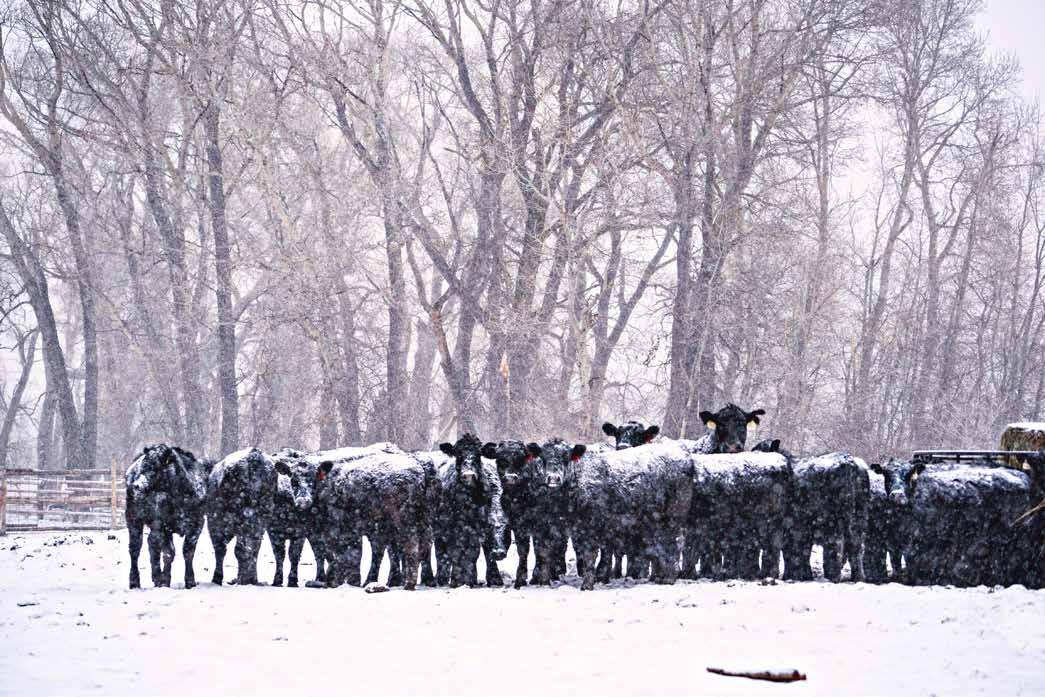



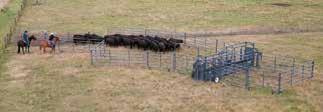




page 28 Winter 2023 START A CONVERSATION TODAY P R O T E C T Y O U R I N V E S T M E N T 417.359.5470 SpecialtyRiskInsuranceAgency com INSURING AGRIBUSINESS, FARM AND RANCH, CROP AND COMMERCIAL SERVICES INCLUDE LIVESTOCK RISK PROTECTION, SAFETY, COMPLIANCE, HR, PAYROLL & MORE The First Hydraulic Corral and still the Largest! Rawhide Processor • Pull on highway at speed limit. • Fits through any gate your pickup will. • Stable on uneven terrain. • Wheels on each panel and electric over hydraulic jack eliminates lifting— saves time. • Frame gates for sorting. • Transport wheels are permanent, no sliding off the axles and rolling out of the way. • Permanent sheeted adjustable alley. Rawhide Portable Corral 900 NORTH WASHINGTON ST., ABILENE, KS 67410 785.263.3436 www.rawhideportablecorral.com 3 Sizes Available! by
John McDonald
2021 experienced a stimulus-fueled surge that extended into the first quarter of 2022. But the spending spree ended by the second quarter when stimulus money dried up, and inflation and economic uncertainty took hold. The positive and negative disruptions of the past few years may mean year-over-year economic metrics aren’t as straightforward as they’d ordinarily be in explaining the consumer’s health.
Inflation: Consumers are unlikely to reduce food and beverage consumption in the face of inflationary pressure. But they will find ways to manage and allocate their food dollars. While inflation is more moderate for food away from home than food at home, the typical restaurant meal costs 3.4 times more than inhome food sourced from retail. To offset rising food costs, consumers are bargain-hunting when grocery shopping, eating more meals at home, and cutting back on restaurant visits.
Income bifurcation: One of the key themes currently shaping the food and beverage landscape is the difference in behaviors among income groups. Trends of upperand lower-income consumers are starkly divergent. In the food and beverage industry, income bifurcation has profound implications for the total share of stomach trends, retailer and restaurant choice, dealing and promotions and brands vs. private labels.
Sticky behaviors: Many eating behaviors adopted during the pandemic reflect a rapid acceleration of behaviors established long before the pandemic, like consumers eating most meals at home. Food and beverage behaviors may continue to “normalize,” but the consumer landscape has been transformed as consumers created new capacities and restaurant operators expanded capabilities to serve a more home-centric consumer.
Total wellness: Due to the pandemic, consumers are finding a balance between foods that contribute to physical wellbeing and those that serve more emotional needs. They’re increasingly in tune with the functional attributes of various foods and beverages that can contribute to both sides of this equation.
Return to convenience: While home-centricity remains more prevalent, the return of mobility reintroduced the need for speed and convenience. For some occasions, this means a trip to a quick
service restaurant, but for others, consumers want to retain their new at-home capacity, just with some shortcuts or time-saving techniques.

“America’s eating patterns are shifting to adjust to new realities, and food manufacturers, foodservice operators, and retailers will need to adjust their offerings and services accordingly,” Portalatin says. “Although the one constant is change, there is a constant to count on, the U.S. consumer will always need to eat, and then it’s a matter of figuring out what, how, when, and where.”
Happy Flew Year
By Wes Ishmael

“What do you reckon he’s cooking up this year?” wondered Peetie Womac. He was staring dejectedly at the fresh bottle of Pearl, slowly turning it with a gnarled thumb and finger. His other hand propped up the worried brow on his weathered face.


“No telling,” said Hooter with a wide grin as he wandered by on his way to punch up another round of Patsy Cline on the War Wagon jukebox.
As Apache Flats’ newly appointed, first-time volunteer mayor, Peetie had good reason for concern.
Basically, little was required of the
mayor to fulfill his responsibilities. Liz Bacon—some claimed she was older that Aunt Pinkie and Nelda Finkelfrack combined—had been taking care of the town’s requisite paperwork for years. All the mayor had to do was oversee coordination of the town’s annual Flew Year Pageant. That was the problem. Each of the town’s previous 10 mayors had been removed from office following the pageant, making the full mayoral term for each not quite 60 days. To a man and three women, each one said upon hearing news of their impeachment, “Thank goodness.”
F&R Livestock Resource page 29
Humor
Patterns ANNUAL ANGUS PRODUCTION SALE SATURDAY, MARCH 4TH, 2023 HIGH NOON • OLSBURG, KS R.D.785-587-5852, Shelie 785-564-0916 Look for Sale Videos and Sale Book online at www.LAFLINRANCH.com MANY MORE LIKE THESE SELL! This is the most dynamic set of bulls and females to ever be offered at Laflin Ranch!
Eating
PARAMOUNT
Elevate to a more valuable female.
For over a decade, Red Angus females have commanded more at auction than all other breeds, including Angus. According to Superior Livestock data, Red Angus heifers brought nearly $17/cwt more –that equates to a $92/head premium on a weaned replacement female.


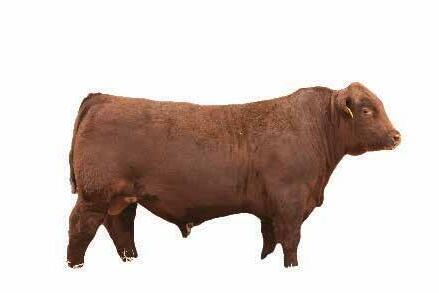



To learn more about industry-leading stayability, visit RedAngus.org

The downfall of each mayor hadn’t been the pageant they helped plan. It was the fact the pageant never came off, exactly, because it was interrupted by an unplanned, unsolicited, potentially fatal pyrotechnics display presented by Rio Rojo’s one known hermit, Lucius “Flash” Stromquist.
Lighting the Fire
If you’re unfamiliar with the Flew Year Pageant, each year the folks in and around Apache Flats gather in front of the War Wagon at sundown on New Year’s Eve to toast the year that was. “I don’t know about the coming year, but we survived this one!” is the motto.
The festivities had always come and gone without a hitch. They built a bonfire in the middle of the street and danced the night away. Then, a decade ago, for some unknown reason, Lucius Stromquist climbed atop the War Wagon, unbeknownst to the crowd below, and set off an explosion of fireworks best described as a fire storm from the south side of Hell.
Huge fireballs lit up the crystalline clear night. The smell of gasoline and burnt gunpowder wafted through the air. Quick as a wink, all you could see were about 40 sets of taillights making a beeline out of both ends of town. All except for Delmar Jacobs, who was already full to the brim with Flew Year cheer, He was still wrestling to unharness the
varmint rifle from his pickup when the boys returned about an hour later.
“T-t-take cover you Comm… comm… comm… pinkos. He-he-here I come,” Delmar kept saying to no one in particular.
Surprisingly, other than a few scorch marks and some spent matches, the top of the saloon was no worse for the wear. Tacked to the back of the false-front sign was an old feed sack with the simple inscription, “Happy Flew Year!”
Through a keen sense of deduction, and the fact that Lucius had signed his name, the town discovered the perpetrator. What took longer to figure out was why he’d done such a thing. Lucius was never mean, far as anyone could remember. He idled his banged-up, rusted Apache pickup into town once a month for supplies. No one knew how he made his money. He just kept to himself on a little patch of ground he owned about 20 miles north of town.
When Lucius showed up to buy supplies a month after his initial heart-stopper, the folks in Apache Flats assumed he had meant no harm; just his way of trying to join in the fun and say Happy Flew Year.
The town kept that in mind the next year when a similar rain of fireballs brewed up unexpectedly at one end of the street. Sure enough, at daybreak they found another feed sack with the




page 30 Winter 2023
March 4, 2023 | Selling Proven, Feed Efficiency Tested Bulls 75 bulls and 35 replacement females. A Different Shorthorn. Marty Loving: 620.786.2018 Scott Loving: 620.786.1369 scott@lovingfarms.com LovingFarms.com Built from generations of data. Refined for profit. Ash Valley Answer 0260 2021 High-selling bull to Leachman Cattle Co of Colorado Ash Valley SL Complete 0408 2022 High-selling bull to Kraus Ranch
same note. Since then, they had come to count on Lucius sending up some type of fireworks, presumably homemade.
“You know how he’s missing the top part of those three fingers?” old man Jesperson had wheezed after the first year’s display. “I used to be in school with him. We called him Flash because he loved chemistry and would’ve made Merlin look like an amateur. He was always mixing up something. That’s how he lost those finger tops, and how we finally got the new school.”
So, the town had come to expect an interruption to the pageant. The problem was that since they didn’t know exactly when to expect it, and because the displays always rained down with such terrifying ferocity, the pageant broke up soon afterward, whether it had been in progress most of the night like most years or only 15 minutes like last year.
Out of sport, if nothing else, the town held the mayor personally responsible for the lack of municipal control. And, no one wanted to approach Lucius to see if they could plan the time of his detonations.
Fanning the Flames
“It’s not like I really want to be mayor,” said Peetie weakly, taking a sip of his beer. “It’s just that I don’t like failing, you know?”
“Yeah, but there ain’t nothing like going out with a bang.” said Hooter.
“That’s not funny.”
“It’s the truth, though.”
“Yeah, Peetie,” said Lonnie Johnson. “Besides, who knows, maybe ol’ Flash will wait until the end of the pageant for the grand finale.”
“You might be the first mayor in a decade to make it to Groundhog’s Day,” said Charlie.
Peetie took a slow, furtive look over both shoulders. “I gotta tell you something, boys. I drove out there to talk with Lucius.”
Silence fell. “What did he say?”
“I never talked to him, exactly. I wanted to, but you should have seen it.” He took a long draw on the bottle as if he couldn’t bear the memory.
“Well, I’d never been out there. So, I’m walking down the drive and I hear the dangdest racket, like a cross between a scalded bobcat and a power sander on sheet metal. I peeked around the corner of a shed and there’s Lucius. He’s all dressed up like a rodeo clown, sitting on some sort of spring-loaded buckin’ barrel. He had spurs on and he’d rake that barrel and scream like a banshee. Then he’d stop. Then he’d start again.”
“Remember when old man Jesperson told us about Flash in school?” said Charlie. “He said something about Lucius rodeoing for a while.”
“I don’t remember that,” said Peetie. “All I know is that a rodeo clown with a
fetish for chemistry sets will make you stop and think.”
“Or just stop,” tried Hooter.
“You did the right thing,” said Lonnie. “Just leaving him alone.”
“Yeah, sleeping dogs and all that,” said Charlie.
Peetie pushed his chair back. “Well, I tried, but it sure didn’t do anything to solve our little dilemma with the pageant.”
“Look on the bright side,” Hooter said. “Maybe he’ll get so wrapped up with that barrel that he’ll forget all about Flew Year.”
Just then they heard a low rumble building from the north. The saloon windows started to darken as if from a quick sunset. A spectacular orange light slowly rose into the sky.
“Or not.”
Editor’s message continued
Continued from page 3
facts, historical facts accumulated over decades.
For all the “wanna be” social media influencers with a cell phone, a YouTube channel and an axe to grind, facts matter. One fact that has remained constant for more than 150 years is our customer is “king.” Today, albeit anecdotal, nary a Saturday shopper at Sam’s Club is demanding beef “Made in the USA.” The customer trusts beef to be safe and healthy. They know beef is nutritious. They are willing to add beef to their shopping cart, knowing it
is the highest priced food item they will purchase. It is every beef industry stakeholder’s responsibility to understand the strengths that have moved beef to the pinnacle of the meat protein space and weaknesses that may threaten our ability to sustain such a lofty market position. What an awesome challenge and an historic opportunity.
I will always like dogs, but never forget a sign posted on the ranch gate of a customer many years ago, “The dog is friendly. Beware of the owner.” We came to realize the sign was based on facts!

F&R Livestock Resource page 31 RANCHES 2346B N Road Strong City, KS 66869 620.340.7461 (Joe) ∙ 620.340.9774 (Daniel) info@mushrushranches.com MushrushRanches.com Follow us on FB at Mushrush Red Angus S truggling with h igh i nput C o S t S ? Mushrush Red Angus Sale Friday, March 17, 2023 at the Ranch near Elmdale, KS 85 - Age-Advantaged Red Angus Bulls 100 - Red Angus & SimAngus Yearlings loaded with Calving Ease & Cow Herd Traits 100 - Fall Bred & Open Spring Yearling Commercial Red Angus Replacements 10 - “U-Pick-Em” Elite Registered Open Heifers We’ve got the Cure for High Input Costs! Mushrush Red Angus genetics are designed to produce more pounds per acre with less feed, fuel and labor. Follow our website for sale updates: MushrushRanches.com
A couple of years ago we had a wreck going and needed a solution. ENDOVAC-Beef was it! A neighbor recommended the product. I knew it didn’t cost much and I knew what I was doing wasn’t working, so when I found out it covered E. coli, Salmonella, Pasteurella, and Mannheimia, I gave it a try. I vaccinated my calves and it worked! Plus, it’s just so easy on them. I give it to my calves around two months of age and again at weaning. The heifers I hold back get it again in June when they go through the chute. It’s just a good product.
The first year we started using ENDOVAC- Beef we had good results. The second year was even better because we implemented it in everything. I vaccinated my cows in April and gave them a booster in June to ensure full protection for my fall calvers and it solved all my scour problems. For those who have spring cows, I would give them a dose in the fall and again in January, about six to seven weeks before they start calving.
Since implementing ENDOVAC-Beef, my medical bill went down and I’m just not treating calves anymore. I haven’t had to doctor one with foot rot either. I can tell you that vaccinating them is cheaper than losing them… it’s worth it. Everything that goes through the chute; cows, calves, and bulls, gets a shot of Endovac at least twice a year now.
 JW Henson, Hillview Farms
JW Henson, Hillview Farms
ENDOVAC-Beef has been a Game Changer for me.
I run a good sized cow-calf operation in addition to starting cattle. 100% of my cattle get ENDOVAC-Beef. Since using ENDOVAC we don’t have to treat as many cattle for respiratory, or even other common problems like pinkeye and foot rot. I am getting my Pasteurella and the stimulant that makes the vaccine work better with ENDOVAC-Beef.

If everybody knew what I knew, everyone would be using it!

Find your nearest rep at EndovacBeef.com 1-800-944-7563 l 6080 Bass Lane l Columbia, MO 65201
Brad Haun, Haun Ranch


































































































































































 By Wes Ishmael
By Wes Ishmael
































 JW Henson, Hillview Farms
JW Henson, Hillview Farms

